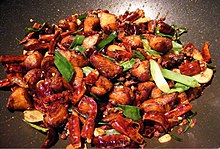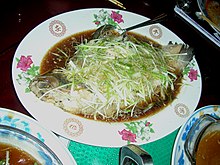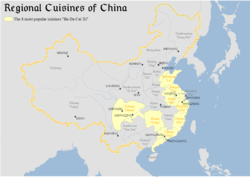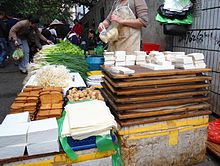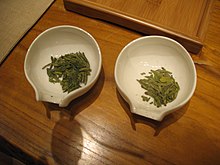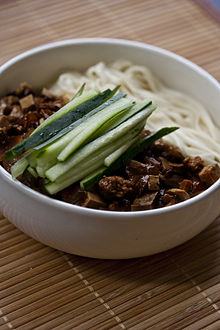Представлено сочинение на английском языке Китайская кухня/ Chinese Cuisine с переводом на русский язык.
| Chinese Cuisine | Китайская кухня |
| Chinese cuisine is one of my favourites. I know that it’s rather old and full of authentic traditions. Over the time there were added some foreign ingredients, but the core of the cuisine remained unchanged. | Китайская кухня является одной из моих любимых. Я знаю, что это довольно старая и наполненная подлинными традициями кухня. Со временем в ней появились некоторые иностранные ингредиенты, но основа осталась неизменной. |
| Perhaps the most famous Chinese dishes include fried rice, sweet-and-sour chicken, Peking duck and turtle soup. Chinese tea is also rather popular and full of useful features. | Возможно, к наиболее известным китайским блюдам относятся жареный рис, кисло-сладкий цыпленок, утка по-пекински и черепаховый суп. Китайский чай также весьма популярен и полон полезных свойств. |
| One of the basic principles of Chinese food is that it should consist of small pieces. Hence the two culinary secrets include the right cut and proper roasting. All in all there are more than thirty ways of cooking there. Food can be quick fried, fried in deep oil layer, cooked in water, vinegar or syrup, fried on low heat, stewed. | Одним из основных принципов китайской кухни является то, что она должна состоять из маленьких кусочков. Отсюда два кулинарных секрета: правильная нарезка и обжарка. В общем, существует более тридцати способы приготовления. Еда может быть быстро обжаренной, жареной в глубоком слое масла, приготовленной в воде, уксусе или сиропе, жареной на медленном огне, тушеной. |
| One of my favourite dishes is the sweet-and-sour chicken. In my opinion, this dish has a very tender taste and I could eat it for lunch, dinner and breakfast. | Одним из моих любимых блюд является кисло-сладкий цыпленок. На мой взгляд, это блюдо имеет очень нежный вкус, и я могла бы есть его на обед, ужин и завтрак. |
| It’s worth mentioning that Chinese people appreciate not only the taste of the dish they prepare, but also the color, aroma and overall appearance. That’s why when we eat Chinese, we get aesthetic pleasure. | Стоит отметить, что китайцы ценят не только вкус блюда, которое они готовят, но и цвет, аромат и общий вид. Вот почему, когда мы едим китайскую еду, мы получаем истинное эстетическое удовольствие. |
| In fact, it’s not a secret that most Chinese dishes are eaten with two chopsticks. It is rather convenient when you are used to them. For example, my mum can’t hold them properly, so she prefers ordinary fork and knife instead. As for me, I have recently learned how to use them, which is why I enjoy eating with chopsticks very much. | На самом деле, не секрет, что большинство китайских блюд едят двумя палочками. Это весьма удобно, когда это привычно. Например, моя мама не может держать их, поэтому она предпочитает обычные вилку и нож. Что касается меня, я недавно поняла, как их использовать, поэтому мне теперь очень нравится есть палочками. |
| For those who try the Chinese for the first time I’d recommend a chicken noodle soup and fortune cookies. | Для тех, кто пробует китайскую еду впервые, я бы порекомендовала куриный суп с лапшой и печенья с предсказаниями. |
Обновлено: 10.03.2023
There are many different delicious dishes in the world. Someone likes to try new food all the time. You go in a new country and you order all the dishes you have never tried. Somebody prefers to eat favorite food and order the same things every time.
I like to go to Japanese restaurant and to eat sushi there. First time when I tried them I didn’t like. But I think I didn’t understand the taste. Later on I wanted to try one more time and since that time sushi have become my favorite food.
But Japanese cuisine has many other delicious dishes. In general people there like to eat natural and healthy food. They choose vegetables, fish, rise and minimal processed food. I think it’s a secret of their beauty, healthy and long life.
Japanese people like to set up the table and to use nice dishes. They follow etiquette even if they are alone at home.
Their classical lunch is soup, rice, 2-3 side dishes and fish. Portions are not big. Soya sauce and wasabi are the most popular species.
People in Japan use fresh products. They don’t like semi-finished products. They also change their menu when the season is changing. They eat mostly seasonal food. Of course they always eat big variety of fish. Only Japanese know how to combine sweet and salty food and to enjoy this meal.
I would like also to say some words about the names of their dishes. For me they are strange, short but still I can’t pronouns many of them.
Very often in the kitchen of Japanese you will find cheese tofu, soy milk, soy sauce, soy pasta miso, rice and adamame. The last thing is boiled beans. All these products are not my favorite, but I have seen few videos and I would like to try traditional lunch or dinner with a Japanese.
Японская кухня
В мире есть много вкусных блюд. Кому-то нравится пробовать новую еду постоянно, где бы он не был. Вот едете вы в новую страну и заказываете только то, что никогда раньше не пробовали. А кто-то предпочитает есть свою любимую еду и заказывает в ресторане одно и то же.
Я люблю ходить в японский ресторан и обычно заказываю суши там. Когда я попробовала их впервые, мне совсем не понравилось. Но мне кажется, я просто не поняла этот вкус. Позже я захотела попробовать суши ещё раз и с тех пор суши стали моим любимым блюдом. Но японская кухня не ограничивается только суши, а имеет много других блюд. А вообще люди в Японии любят есть здоровую и натуральную еду. Они предпочитают сезонные овощи, рыбу, рис и минимум обработанную пищу. Мне кажется, в этом и кроется секрет красоты, здоровья и долголетия японцев.
Японцы любят сервировать стол и используют красивую посуду. Они следуют этикету, даже, если обедают в одиночестве. Их обычный обед состоит из супа, риса, 2-3 гарниров и рыбы. Порции там совсем не большие. Соевый соус и васаби — самые популярные приправы у японцев.
Японцы при готовке используют только свежие продукты. Они совершенно не поклонники полуфабрикатов. А ещё они сменяют своё ежедневное меню, как только меняется сезон на тот или иной продукт. В основном они питаются сезонными продуктами. А ещё у них есть огромный выбор рыбы. Только японцы знают, как сочетать сладкое и соленое и получить по-настоящему вкусное блюдо.
Также хочется сказать немного о самих названиях блюд. По-моему, они все странные, короткие, но все равно их сложно произносить.
Часто на кухне у японца вы найдёте сыр тофу, соевое молоко, соевый соус, соевую пасту мисо, рис и адамаме. Последнее — это отварные бобы. Все эти продукты мне не особо нравятся, но я видела видео, как выглядит их обед. Честно говоря, я бы хотела попробовать традиционный японский обед или ужин.
- Для учеников 1-11 классов и дошкольников
- Бесплатные сертификаты учителям и участникам
Описание презентации по отдельным слайдам:
Chinese cuisine Выполнила: Топалян Марина Погосовна
Chinese cuisine includes styles originating from the diverse regions of China, as well as from Chinese people in other parts of the world. One style may favour the use of lots of garlic and shallots over lots of chilli and spices, while another may favour preparing seafood over other meats and fowl.
Staple foods Rice is a major staple food for people from rice farming areas in southern China. Rice is one of the most popular foods in China and is used in many dishes. Glutinous rice («sticky rice») is a variety of rice used in many specialty Chinese dishes.
Chinese noodles come dry or fresh in a variety of sizes, shapes and textures and are often served in soups or fried as toppings. Tofu is made of soybeans and is another popular food product that supplies protein. Other products such as soy milk, soy paste, soy oil, and fermented soy sauce are also important in Chinese cooking.
Spices and seasonings such as fresh ginger root, garlic, scallion, white pepper, and sesame oil are widely used in many regional cuisines. Sichuan peppercorns, star anise, cinnamon, fennel, cilantro, parsley, and cloves are also used.
Chinese sausage is darker and thinner than western sausages.
China was the earliest country to cultivate and drink tea The spirit of the tea ceremony embodies the basic principles of harmony, respect, purity, appreciation and tranquility. The tea ceremony is a way to focus on mental spirituality, relaxation, and to enjoy a tradition that is thousands of years old.
津津有味 bon appetit
- подготовка к ЕГЭ/ОГЭ и ВПР
- по всем предметам 1-11 классов
Курс повышения квалификации
Дистанционное обучение как современный формат преподавания
Курс профессиональной переподготовки
Английский язык: теория и методика преподавания в образовательной организации
- Сейчас обучается 1147 человек из 83 регионов
Курс повышения квалификации
Специфика преподавания английского языка с учетом требований ФГОС
- ЗП до 91 000 руб.
- Гибкий график
- Удаленная работа
Дистанционные курсы для педагогов
Свидетельство и скидка на обучение каждому участнику
Найдите материал к любому уроку, указав свой предмет (категорию), класс, учебник и тему:
5 606 200 материалов в базе
Самые массовые международные дистанционные
Школьные Инфоконкурсы 2022
Свидетельство и скидка на обучение каждому участнику
Другие материалы
Вам будут интересны эти курсы:
Оставьте свой комментарий
- 25.10.2015 3957
- PPTX 2.3 мбайт
- 47 скачиваний
- Рейтинг: 5 из 5
- Оцените материал:
Настоящий материал опубликован пользователем Топалян Марина Погосовна. Инфоурок является информационным посредником и предоставляет пользователям возможность размещать на сайте методические материалы. Всю ответственность за опубликованные материалы, содержащиеся в них сведения, а также за соблюдение авторских прав несут пользователи, загрузившие материал на сайт
Если Вы считаете, что материал нарушает авторские права либо по каким-то другим причинам должен быть удален с сайта, Вы можете оставить жалобу на материал.
Автор материала
40%
- Подготовка к ЕГЭ/ОГЭ и ВПР
- Для учеников 1-11 классов
Московский институт профессиональной
переподготовки и повышения
квалификации педагогов
Дистанционные курсы
для педагогов
663 курса от 690 рублей
Выбрать курс со скидкой
Выдаём документы
установленного образца!
Учителя о ЕГЭ: секреты успешной подготовки
Время чтения: 11 минут
В Белгородской области отменяют занятия в школах и детсадах на границе с Украиной
Время чтения: 0 минут
Минтруд предложил упростить направление маткапитала на образование
Время чтения: 1 минута
Каждый второй ребенок в школе подвергался психической агрессии
Время чтения: 3 минуты
В Россию приехали 10 тысяч детей из Луганской и Донецкой Народных республик
Время чтения: 2 минуты
Минпросвещения России подготовит учителей для обучения детей из Донбасса
Время чтения: 1 минута
Отчисленные за рубежом студенты смогут бесплатно учиться в России
Время чтения: 1 минута
Подарочные сертификаты
Ответственность за разрешение любых спорных моментов, касающихся самих материалов и их содержания, берут на себя пользователи, разместившие материал на сайте. Однако администрация сайта готова оказать всяческую поддержку в решении любых вопросов, связанных с работой и содержанием сайта. Если Вы заметили, что на данном сайте незаконно используются материалы, сообщите об этом администрации сайта через форму обратной связи.
Все материалы, размещенные на сайте, созданы авторами сайта либо размещены пользователями сайта и представлены на сайте исключительно для ознакомления. Авторские права на материалы принадлежат их законным авторам. Частичное или полное копирование материалов сайта без письменного разрешения администрации сайта запрещено! Мнение администрации может не совпадать с точкой зрения авторов.
Chinese cuisine is rather old and full of authentic traditions. Over the time there were added some foreign ingredients, but the core of the cuisine remained unchanged.
Perhaps the most famous Chinese dishes include fried rice, sweet-and-sour chicken, Peking duck and turtle soup.
China’s Regional Food Types The main features of China’s regional cuisines can be described as follows : China can be divided into several regions with distinct styles of cooking. The ingredients used are based on the natural and agricultural products of each region. The main features of China’s regional cuisines can be described as follows:
Northern China food — salty, simple, less vegetables with wheat as the staple food. Food using wheat as its main ingredient, such as noodles and dumplings is prevalent there.
Western China food — hearty halal food
Eastern China food — sweet and light
Central China food — spicy with a lot of seasonings
Southern minority food — sour, and many minorities eat chilies every day
One of the basic principles of Chinese food is that it should consist of small pieces. And the two culinary secrets include the right cut and proper roasting.
ways of cooking At all there are more than thirty ways of cooking there. Food can be quick fried, fried in deep oil layer, cooked in water, vinegar or syrup, fried on low heat, stewed.
Interesting ingredients for sauce: Slurry – equal parts of corn starch and water mix. Sherry- English : /ˈ ʃɛri / , Spanish : Jerez [ xeˈɾeθ ] is a fortified wine made from white grapes that are grown in Spain .
The 8 Most Popular Chinese Dishes You Should Try
Sweet and Sour Pork Sweet and sour pork ( 糖醋里脊 ) has a bright orange-red color, and a delicious sweet and sour taste.At the beginning there was only sweet and sour pork, but to meet demands, there have been some developments on this dish. Now, the pork can be substituted by other ingredients like chicken, beef or pork ribs.
Kung Pao Chicken Kung Pao Chicken ( 宫保鸡丁 ) is a famous Sichuan-style specialty, popular with both Chinese and foreigners. The major ingredients are diced chicken, dried chili, and fried peanuts. People in Western countries have created a Western-style gong bao chicken, for which the diced chicken is covered with cornstarch, and vegetables, sweet and sour sauce and mashed garlic are added.
Ma Po Tofu Ma po tofu ( 麻婆豆腐 ) is one of the most famous dishes in Chuan Cuisine with a history of more than 100 years. Ma (麻) describes a spicy and hot taste which comes from pepper powder, one kind of condiment usually used in Chuan Cuisine. The milky tofu is enriched with brownish red beef and chopped green onion. It is really a tasty delicacy.
Wontons Since the Tang Dynasty (618–907), it has been a custom for people to eat wontons ( 馄饨 ) on the winter solstice. The most common shape of a wonton is simple a right triangle, similar to Italian tortellini. Wontons are commonly boiled and served in soup or sometimes deep-fried. The filling of wontons can be minced pork or diced shrimp.
Dumplings With a long history of more than 1,800 years, dumplings are a traditional food widely popular in North China. Dumplings ( 饺子 ) consist of minced meat and chopped vegetables wrapped into a thin piece of dough skin. Popular fillings are mince pork, diced shrimp, ground chicken, beef, and vegetables. They can be cooked by boiling, steaming, or frying. Dumplings are a traditional dish eaten on Chinese New Year’s Eve.
Chow Mein The «Chow mein » ( 炒面 ) is the Cantonese pronunciation of the Chinese characters above, which means stir-fried noodles. Generally speaking, this stir-fried dish consists of noodles, meat (usually chicken, beef, shrimp, or pork), onions and celery. For making chow mein , the noodles need to be cooked in boiling water for a while. After they becoming cool, then move to the step of stir-frying.
Peking Roasted Duck Peking duck ( 北京烤鸭 ) is a famous dish from Beijing, enjoying world fame, and considered as one of China’s national dishes. Peking duck is savored for its thin and crispy skin. The Sliced Peking duck is often eaten with pancakes, sweet bean sauce, or soy with mashed garlic. It is a must-taste dish in Beijing!
Spring Rolls Spring rolls ( 春卷 ) are popular dish! The filling of spring rolls could be vegetables or meat, and the taste could be either sweet or savory. After fillings are wrapped in spring roll wrappers, the next step is frying. Then the spring rolls are given their golden yellow color.
По теме: методические разработки, презентации и конспекты
конспект открытого урока по немецкому языку на тему «Особенности немецкой кухни»
Цель разработки открытого урока по немецкому языку «Особенности немецкой кухни»- показать всевозможные средства обучения при изучении темы раздела «Кухни народов мира». Для обучающихся важно разыграть.
презентация к открытому уроку по теме «Особенности немецкой кухни»
Цель открытого урока «Особенности немецкой кухни» — показать всевозможные средства обучения при изучении темы «Кухни народов мира». Цель изучения иностранного языка в техникуме — уметь применять.
Методическая разработка на тему: Приготовление блюд зарубежной кухни. Корейская кухня
Данная методическая разработка на тему: Приготовление блюд зарубежной кухни.Корейская кухня предназначена для теоретического и практического обучения студентов, обучающихся по спе.
Разработка учебного занятия по теме: «Мир в конце XX – начале XXI века. Международные отношения на примере американо-китайских отношений»
Помощь учителю в проведии урока по Всеобщей истории.
«Китайская живопись» (презентация по композиции)
Одним из важнейших достижений древнекитайского искусства является живопись. Китайская картина — свиток — это совершенно новый вид искусства. Близость к природе, стремление к духовному совершенству, по.
Вы можете изучить и скачать доклад-презентацию на тему Национальная кухня Китая. Презентация на заданную тему содержит 15 слайдов. Для просмотра воспользуйтесь проигрывателем, если материал оказался полезным для Вас — поделитесь им с друзьями с помощью социальных кнопок и добавьте наш сайт презентаций в закладки!
Национальная кухня Китая хорошо известна во всём мире, Это очень древняя кухня, которая своими корнями уходит ещё в эпоху неолита. Национальная кухня Китая хорошо известна во всём мире, Это очень древняя кухня, которая своими корнями уходит ещё в эпоху неолита. Китай — огромная страна, поэтому в каждом регионе существует своя национальная кухня, обусловленная климатическими особенностями, географическим положением, историей и традициями соответствующего региона.
Существуют так называемые восемь видов китайской кухни : Существуют так называемые восемь видов китайской кухни :
Рисовая лапша ( гоцяомисянь)— крестики мост Рисовая лапша : Рисовая лапша ( гоцяомисянь)— крестики мост Рисовая лапша : Это традиционное блюдо провинции Юньнань, в основе которого лежит рисовая лапша. 1:чашки заранее приготовленной лапши; 2:большой чашки жирного очень горячего куриного (мясного) бульона; 3:чашки с нарезанной свининой, печенью и курицей, шинкованными свежими овощами.
Обедающему необходимо лишь опустить мясо, овощи и лапшу в бульон и можно приступать к трапезе. Обедающему необходимо лишь опустить мясо, овощи и лапшу в бульон и можно приступать к трапезе.
И почему лапша называется крестики мост Рисовая лапша ? в стародавние времена одного ученого посадили в тюрьму, которая находилась на острове посреди озера. Каждый день его жена переходила на остров по мосту и приносила ему еду. Но как бы она ни старалась, еда остывала быстрее, чем ей удавалось дойти до места заключения мужа. Мудрая женщина нашла выход из ситуации: она заметила, что жирный куриный бульон остывает намного медленнее других продуктов. Тогда она стала приносить их отдельно, а на месте выкладывать в бульон.
Читайте также:
- Доклад по ачс 2019
- Приборы для измерения скорости и ускорения доклад
- Доклад на тему файлы и папки 5 класс
- Цифровизация в библиотеке доклад
- А пластов презентация и доклад
Curious to know what real, traditional Chinese food looks like?
This isn’t that imitation Chinese food you get from the 24-hour Chinese restaurants around the corner from your apartment. I lived and traveled in China for ten months and lived off the real deal, local Chinese cuisine of the cities and villages.
Trust me, there’s more to Chinese cuisine than Dim Sum and Kung Pao Chicken. Once you taste authentic Chinese food, you’ll never want to eat from the food court in the mall again.
These are 15 of my favorite traditional Chinese foods!
1. Spinach Noodles

This dish, known as bō cài miàn (菠菜面) in Chinese, includes handmade noodles from spinach, topped with whatever ingredients your heart desires.
Xi’an, in central China, is known for its noodles, and every self-respecting noodle joint in the city makes their noodles from scratch.
The above serving has a spicy tomato-like sauce and is topped with egg, potato, carrots, beef and chili.
2. Stir-Fried Shaanxi Pasta
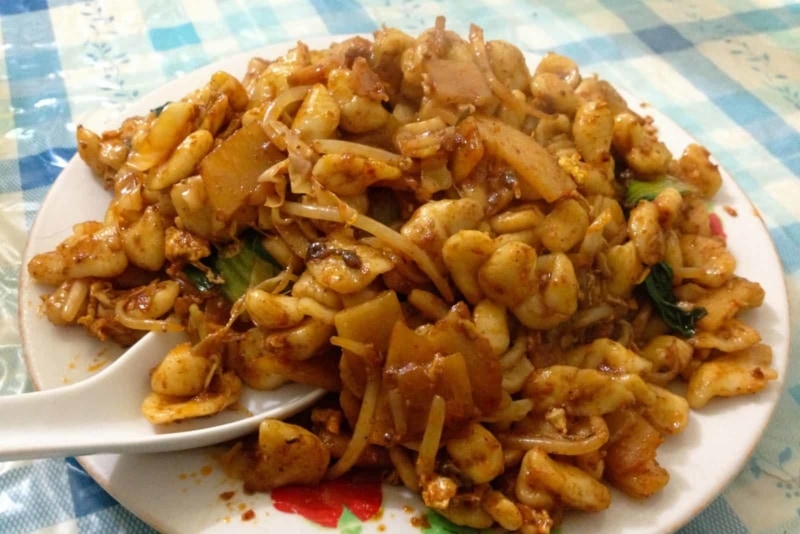
It’s easy to find fried rice and fried noodles anywhere in the world. Chǎo má shi (炒麻食) a gnocchi-lookalike, though, is quite different. It’s a little bit sweet, but it’s hot and hearty.
The additional crunchy vegetables provide a delicious juxtaposition next to the soft thickness of the má shi.
3. Barbecue Street Meat Kebabs
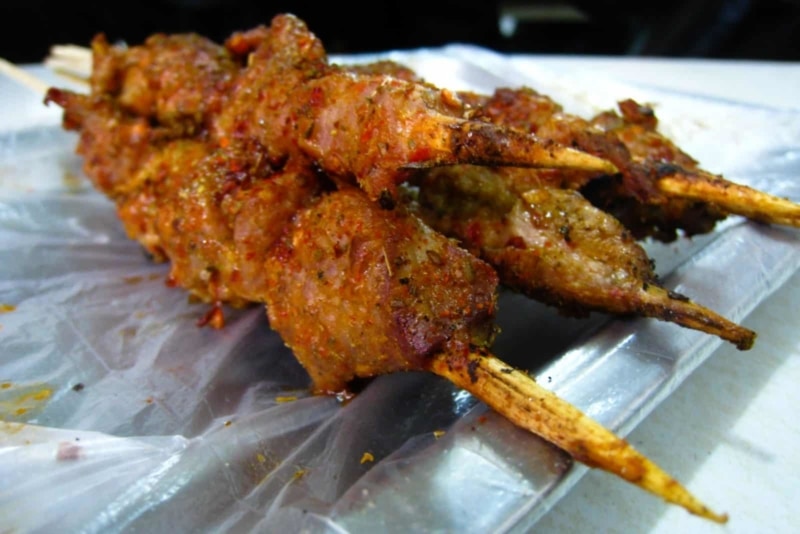
Kǎo ròu (烤肉) is the standard serving of meat in China and might be one of the most well known Chinese dishes available. They are heavily spiced and come from both restaurants and street carts alike.
Often cooked over burning coal, these sticks of meat come in many variations. You might find braised pork, lamb, beef, chicken, or even the gizzards and other weird stuff no westerner would happily stick in their mouth.
And yes, I’ve seen tentacles hanging out of peoples’ mouths.
4. Cold Vegetable Dish
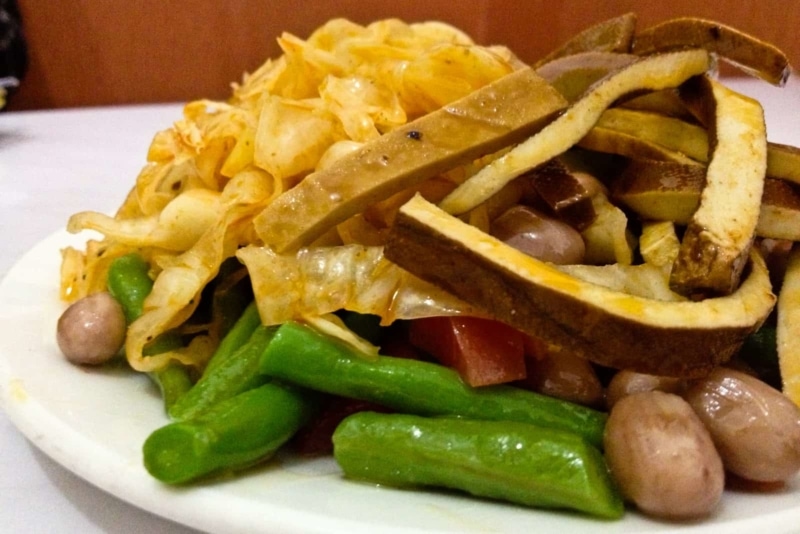
Liáng cài (凉菜), which literally translates to “cold dish,” is an assortment of vegetables, tofu and peanuts, served with a marinade or sauce.
The usual suspects are green beans, cucumbers, lotus root and cabbage, amongst a brilliant assortment of whatever else the house thinks bests suits the dish!
5. Stinky Tofu
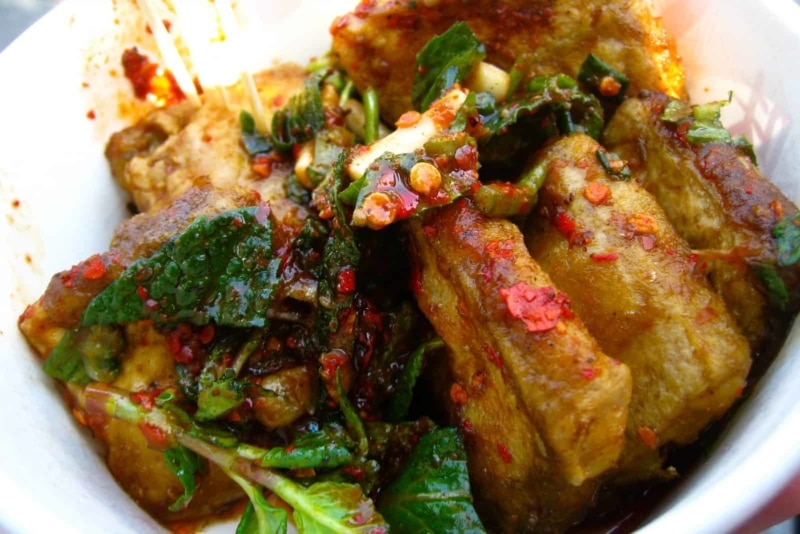
It smells worse than it looks and it actually tastes better than it smells!
Stinky tofu, aka chòu dòufu (臭豆腐) is often the culprit when entire sidewalks full of people are choked out as they are engulfed in a thick haze of stench. With enough of the right seasoning (you can see they use a lot), this Chinese dish actually ain’t half bad.
6. Dumplings
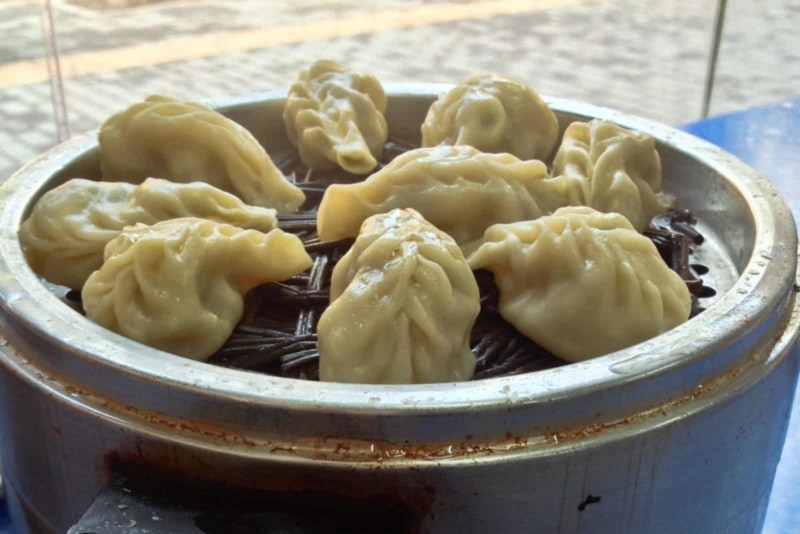
Another one of the most well-known Chinese dishes, this is your classic dumpling (jiǎo zi or 饺子), often filled with beef, pork, shrimp or veggies—but never chicken! They can come steamed or fried and, man, do they taste good. Even though they are regarded as a staple of dim sum—which is local to southern China—dumplings are found all over the country.
My favorite way to enjoy these was by dipping them in black vinegar mixed with a chili sauce, which adds a unique bitter, sweet and spicy flavor. In the U.S., standard practice is to dip in soy sauce, but not in China!
7. Mutton & Bread Stew
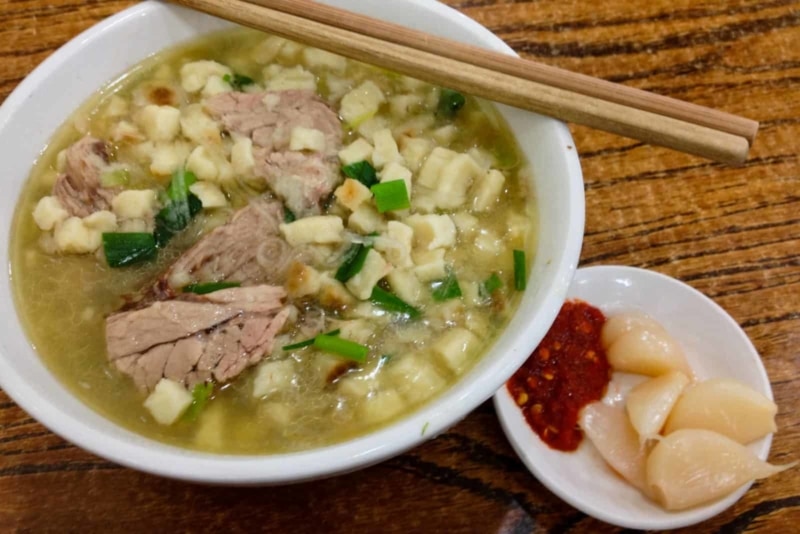
Yáng ròu pào mó (羊肉泡馍) is a traditional dish of the Xi’an people. Seen here is pào mó served with mutton, though it can also come with pork or beef. Instead of noodles, this stew uses bits of unleavened bread, which soaks up the rich flavor. It’s served with chili sauce and pickled garlic on the side, meant for eating on its own, alongside the stew.
It compliments the flavors, and wards off evil spirits in the process.
8. Chinese Hamburger
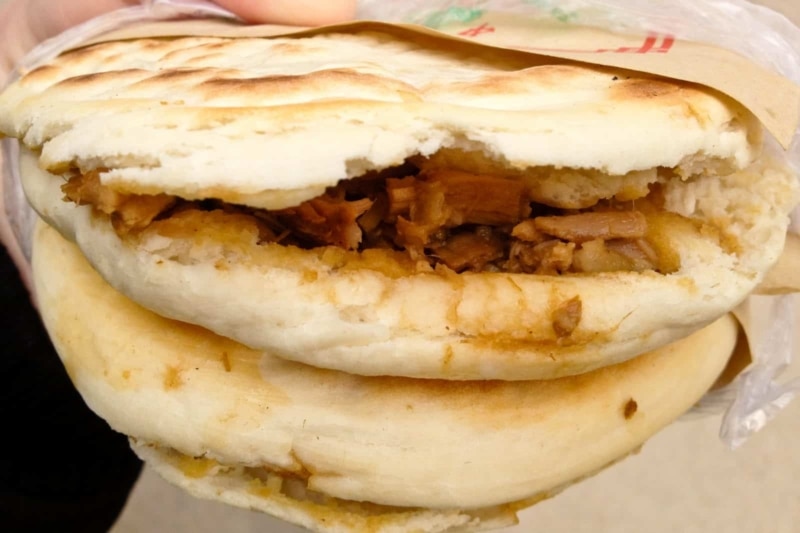
The ròu jiā mó (肉夹馍) is the Chinese answer to a western hamburger, though, as a burger aficionado, I take serious issue with the fact that anybody would even call this one. That being said, these rolls are tasty treats.
It’s a homemade, stone-oven cooked bun with juicy braised pork on the inside. The pork is left to cook overnight in a large pot of spices like cardamom and cloves, and by morning, the meat would fall right apart. We called them “ro-ji’s” for short!
9. Cold Tofu and Pineapple Aloe Vera
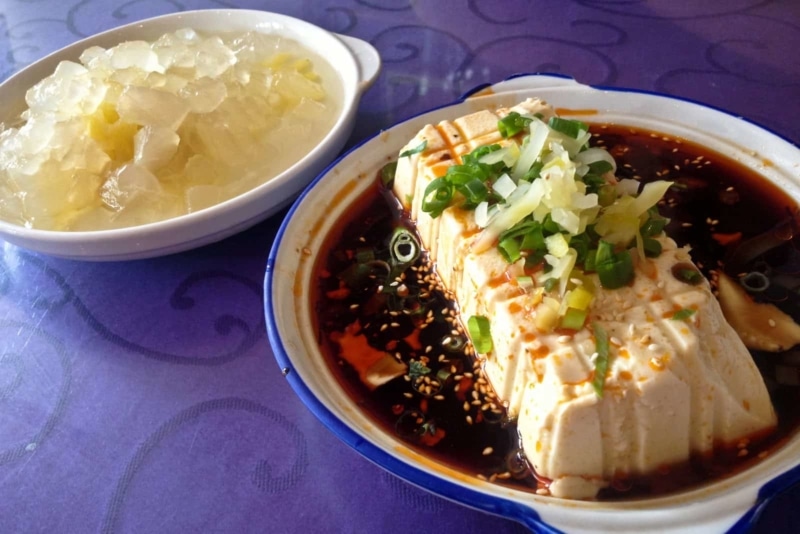
Seen here is a giant brick of tofu (I know, right?) known as liáng bàn dòufu (凉拌豆腐) which is sitting in a mixed sauce of oil, chili and sesame (among other unknown flavors), topped with green veggies.
The bizarre dish behind it is a serving of pineapple and aloe vera….the very same aloe vera you use to treat a sunburn. Known as bōluó lúhuì (菠萝芦荟), it’s sweet and mushy, which I couldn’t enjoy, but the sugary pineapple underneath was a nice nosh!
10. Yak Meat Dumplings
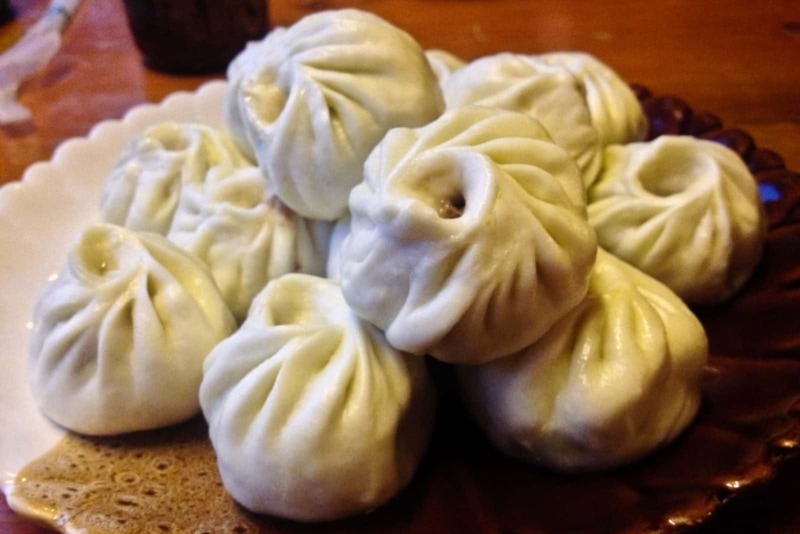
Though not a traditional food of China, mómo (饃饃) are common in Tibet and Western China. There is conflict over the territory of Tibet, but I did eat these in the People’s Republic of China, so they made the list.
These dumplings rolls were filled with juicy yak meat that burst in my mouth when I bit down. This, here, is one of the greatest things I’ve ever eaten in my life.
And I’ve eaten a lot. About three times every day since I was born, in fact.
11. Sichuan Eggplant
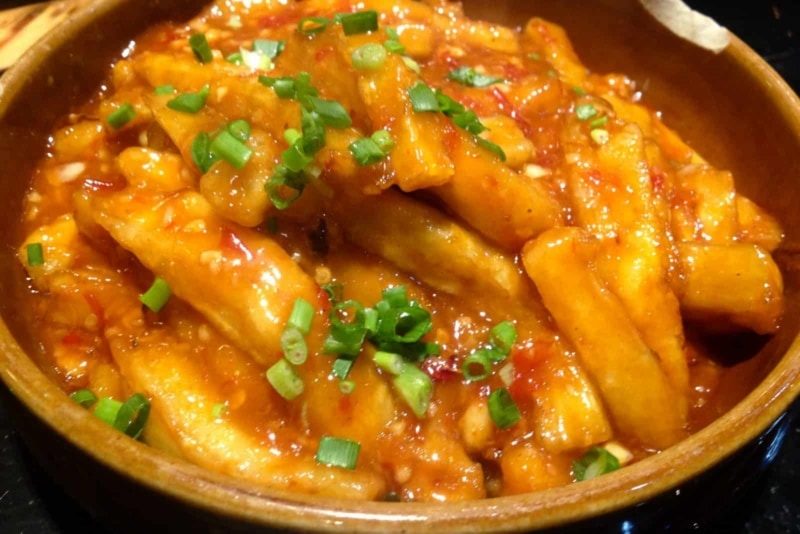
Though I never enjoyed eggplant at home, it quickly became my favorite food in China! Yú xīang qié zi (鱼香茄子) is is a bowl of stir-fried eggplant that tastes more like sweet and sour pork than a vegetable. A little bit of chili and fish sauce can go a long way!
12. Beef Noodles
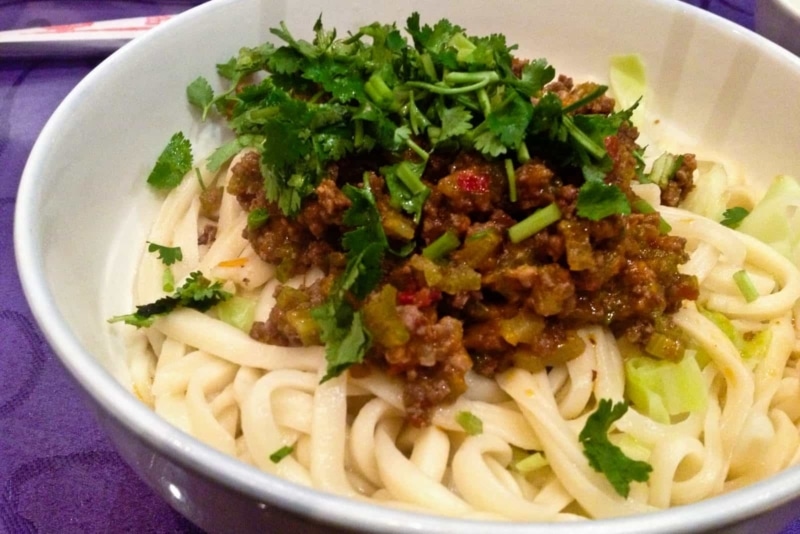
Beef noodles are a personal favorite, and they can be found in almost every restaurant or household in China. In fact, I’d go so far as to say that niú ròu miàn (牛肉面) is the most traditional Chinese dish there is.
Each restaurant prepares their noodles differently, so eating the same thing never gets boring. Seen here are homemade noodles, topped with a shredded beef and vegetable mixture from one of my favorite local Chinese restaurants in Xi’an.
13. Peking Duck
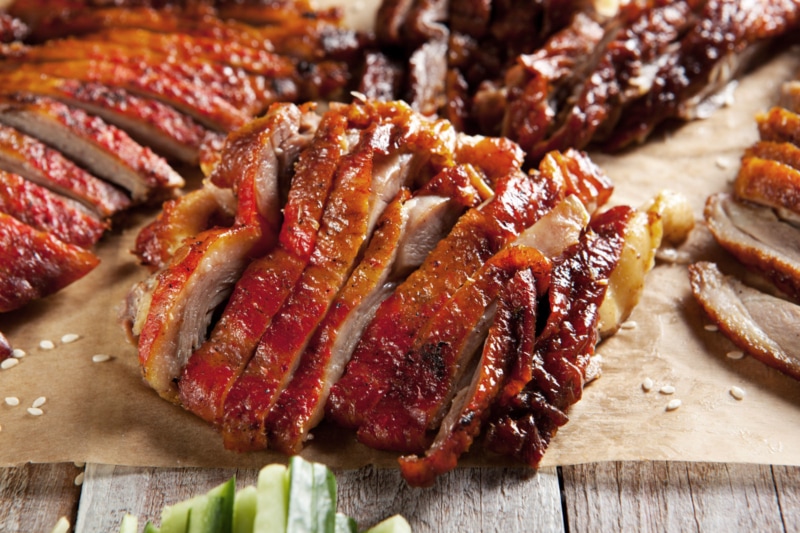
Just thinking about thin crispy duck skin is enough to make my mouth water.
Originally from Beijing, Peking Duck—Běijīng kǎoyā (北京烤鴨)—is a staple dish of Chinese cuisine. The ducks cooked in an open-air oven for over 24 hours before being served with steamed rolls, spring onions and sweet bean sauce.
If you’re in Beijing, you can expect to wait several hours just to be served at a peking duck restaurant. But having the succulent Peking Duck sliced and served directly at your table is absolutely worth the wait.
14. Phoenix Tail Shrimp
Get your fried food fix with a taste of freshly battered Phoenix Tail Shrimp.
An Anhui specialty, this crispy shrimp dish known as fèngwěi xiāpái (凤尾虾排) is usually eaten as a snack or appetizer. The shrimp is battered with flour and spices before being fried with their tails intact. When the shrimp is served, this delicious China food resembles the tail of a mythical Phoenix, hence the name.
15. Fried Rice
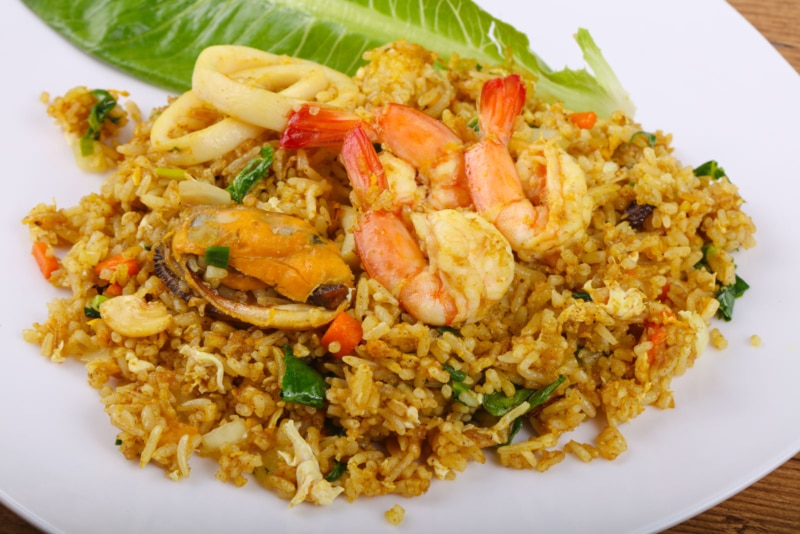
No list of Chinese cuisine would be complete with one of the most classic Chinese dishes of all time—fried rice (chǎofàn or 炒饭).
Although the main ingredients are the same, different regions of China produce different versions of fried rice. Sichuan rice is served with a spicy chili sauce, Canton rice is topped with gravy, and ying-yang rice is made with tomato sauce.
And I love the shrimp in Yangzhou rice. Made with both barbecue pork and shrimp, this version is the most popular type of fried rice in China.
The funny part, though, is that you won’t typically find chicken friend rice in China, which is a popular Chinese food in the States!
****
Traditional Chinese recipes are very different from the Chinese cuisine you might be used to. Western countries have, unfortunately, changed the cuisine, and turned it into something more akin to a greasy, late-night snack.
Dishes like General Tso Chicken are Americanized versions of Chinese cuisine and have almost no correlation to the Chinese culture whatsoever.
That being said, with the uprising of gourmet and artisanal restaurants, many Chinese menus are turning into something more representative of the authentic experience.
If you ever get a chance to experience traditional Chinese food, I highly recommend you try it!
What’s your favorite Chinese food? Let us know in the comments below!
READ MORE:
- 2 Week China Itinerary
- Is China Safe to Travel?
- The Best Travel Insurance for China
- The Cost of Travel in China
Сочинение на тему «Кухни мира»на английском языке с переводом на русский язык |
|
Кухни мира |
|
|
Cuisine is an important part of any national culture. Food expresses a nation’s mentality and traditions as well as the way people dress, behave, furnish their houses, understand such concepts as family, work, love, friendship, success, etc. Cooking and eating habits not only influence our everyday life, but also reflect our history and traditions. |
Кухня – важная часть любой национальной культуры. Еда выражает национальную ментальность и традиции наряду с тем, как люди одеваются, ведут себя, обставляют дом, с их пониманием таких концептов, как семья, работа, любовь, дружба, успех и т. д. Привычки, связанные с приготовлением и употреблением пищи, не только влияют на нашу повседневную жизнь, но и отражают историю и традиции. |
|
Each culture is closely associated with its cuisine; thus, food is tied to the stereotypes about a nation, to its cultural image. For example, it is hard to imagine Italians without pizza, pasta, and wine. A real Italian person may hate all these things, but the idea of Italy formed by our cultural background is tied to them anyway. |
Каждая культура плотно ассоциируется со своей национальной кухней; поэтому еда связана со стереотипами о нации, с её культурным образом. Например, трудно представить итальянцев без пиццы, пасты и вина. Настоящий итальянец может ненавидеть всё это, но представление об Италии, сформированное нашим культурным фоном, в любом случае с этим связано. |
|
There is a great variety of cuisines, and nowadays everyone may taste any national dish, drink, or product in a restaurant or a café. French cuisine is one of the most famous and favorite in Europe; it includes a lot of dishes of vegetables (for example, ratatouille), various kinds of baking (baguette, croissants) and sorts of cheese, delicious desserts (éclair, meringue, crème brulee), and, of course, wine and cognac. American cuisine is always associated with fast food (burgers, hot dogs, various sandwiches, French fries), fizzy drinks (especially Coca-Cola), and such desserts as cheesecake, donuts, and apple pie. The most popular cuisines of the Eastern world are Japanese and Chinese ones. The first is associated, primarily, with sushi and miso soups; the second one – with wok and other spicy dishes. Russian cuisine is famous for borsch and other national soups, dumplings, pancakes with sour cream or honey, pies, etc. |
Существует огромное разнообразие национальных кухонь, и в наши дни каждый может попробовать любое национальное блюдо, напиток или продукт в ресторане или кафе. Французская кухня – одна из самых знаменитых и любимых в Европе; она включает множество блюд из овощей (например, рататуй), различные виды выпечки (багет, круассаны) и сорта сыра, вкусные десерты (эклер, безе, крем-брюле) и, конечно, вино и коньяк. Американская кухня всегда ассоциируется с фастфудом (бургерами, хот-догами, различными сэндвичами, картошкой фри), газированными напитками (особенно с «Кока-Колой») и такими десертами, как чизкейк, пончики и яблочный пирог. Самыми популярными национальными кухнями в восточном мире являются японская и китайская. Первая ассоциируется, главным образом, с суши и мисо-супом; вторая – с воком (китайской лапшой) и другими острыми блюдами. Русская кухня славится борщом и другими национальными супами, пельменями, блинами со сметаной или мёдом, пирожками и т. д. |
«Chinese food» redirects here. For international Chinese cuisine variations, see § Chinese cuisines outside China. For other uses, see Chinese food (disambiguation).
Chinese cuisine encompasses the numerous cuisines originating from China, as well as overseas cuisines created by the Chinese diaspora. Because of the Chinese diaspora and historical power of the country, Chinese cuisine has influenced many other cuisines in Asia and beyond, with modifications made to cater to local palates. Chinese food staples such as rice, soy sauce, noodles, tea, chili oil, and tofu, and utensils such as chopsticks and the wok, can now be found worldwide.
The preferences for seasoning and cooking techniques of Chinese provinces depend on differences in social class, religion, historical background, and ethnic groups. Geographic features including mountains, rivers, forests, and deserts also have a strong effect on the local available ingredients, considering that the climate of China varies from tropical in the south to subarctic in the northeast. Imperial royal and noble preference also plays a role in the change of Chinese cuisine. Because of imperial expansion and trading, ingredients and cooking techniques from other cultures have been integrated into Chinese cuisines over time.
There are numerous regional, religious, and ethnic styles of Chinese cuisine found within China and abroad. Chinese cuisine is highly diverse and most frequently categorised into provincial divisions, although these province-level classifications consist of many more styles within themselves. The most praised Four Great Traditions in Chinese cuisine are Chuan, Lu, Yue, and Huaiyang, representing cuisines of West, North, South, and East China, respectively.[1] The modern Eight Cuisines of China are Anhui (徽菜; Huīcài), Guangdong (粤菜; Yuècài), Fujian (闽菜; Mǐncài), Hunan (湘菜; Xiāngcài), Jiangsu (苏菜; Sūcài), Shandong (鲁菜; Lǔcài), Sichuan (川菜; Chuāncài), and Zhejiang (浙菜; Zhècài) cuisines.[2]
Color, scent and taste are the three traditional aspects used to describe Chinese food,[4] as well as the meaning, appearance, and nutrition of the food. Cooking should be appraised with respect to the ingredients used, knife work, cooking time, and seasoning.
History[edit]
Pre-Tang dynasty[edit]
Dàzhǔ gānsī is a typical soup dish of Huaiyang cuisine. It is made of finely sliced dried tofu, chicken, ham and bamboo shoot, and the ingredients need to be braised with shrimp in chicken soup. It was highly praised by the Qianlong emperor.[5]
Steamed whole perch with roe inside. Sliced ginger and spring onion is usually spread on top.
Chinese society greatly valued gastronomy, and developed an extensive study of the subject based on its traditional medical beliefs. Chinese culture initially centered around the North China Plain. The first domesticated crops seem to have been the foxtail and broomcorn varieties of millet, while rice was cultivated in the south. By 2000 BC, wheat had arrived from western Asia. These grains were typically served as warm noodle soups instead of baked into bread as in Europe. Nobles hunted various wild game and consumed mutton, pork and dog as these animals were domesticated. Grain was stored against famine and flood and meat was preserved with salt, vinegar, curing, and fermenting. The flavor of the meat was enhanced by cooking it in animal fats though this practice was mostly restricted to the wealthy.[6]
By the time of Confucius in the late Zhou, gastronomy had become a high art. Confucius discussed the principles of dining: «The rice would never be too white, the meat would never be too finely cut… When it was not cooked right, man would not eat. When it was cooked bad, man would not eat. When the meat was not cut properly, man would not eat. When the food was not prepared with the right sauce, man would not eat. Although there are plenty of meats, they should not be cooked more than staple food. There is no limit for alcohol, before a man gets drunk.»[7] The Lüshi chunqiu notes: «Only if one is chosen as the Son of Heaven will the tastiest delicacies be prepared [for him].»[8]
The Zhaohun (4-3rd c. BC) gives some examples: turtle ragout, honey cakes and beer (chilled with ice).
During Shi Huangdi’s Qin dynasty, the empire expanded into the south. By the time of the Han dynasty, the different regions and cuisines of China’s people were linked by major canals and leading to greater complexity in the different regional cuisines. Not only is food seen as giving «qi», energy, but the food is also about maintaining yin and yang.[9] The philosophy behind it was rooted in the I Ching and Chinese traditional medicine: food was judged for color, aroma, taste, and texture and a good meal was expected to balance the Four Natures (‘hot’, warm, cool, and ‘cold’) and the Five Tastes (pungent, sweet, sour, bitter, and salty).
Salt was used as a preservative from early times, but in cooking was added in the form of soy sauce, and not at the table.[10]
By the Later Han period (2nd century), writers[who?] frequently complained of lazy aristocrats who did nothing but sit around all day eating smoked meats and roasts.
During the Han dynasty, the Chinese developed methods of food preservation for military rations during campaigns such as drying meat into jerky and cooking, roasting, and drying grain.[11]
Chinese legends claim that the roasted, flat bread shaobing was brought back from the Xiyu (the Western Regions, a name for Central Asia) by the Han dynasty General Ban Chao, and that it was originally known as hubing (胡餅, lit. «barbarian bread»). The shaobing is believed to be descended from the hubing.[12] Shaobing is believed to be related to the Persian nan and Central Asian nan, as well as the Middle Eastern pita.[13][14][15][16] Foreign westerners made and sold sesame cakes in China during the Tang dynasty.[17]
During the Southern and Northern dynasties non-Han people like the Xianbei of Northern Wei introduced their cuisine to northern China, and these influences continued up to the Tang dynasty, popularizing meat like mutton and dairy products like goat milk, yogurts, and Kumis among even Han people. It was during the Song dynasty that Han Chinese developed an aversion to dairy products and abandoned the dairy foods introduced earlier.[18]
The Han Chinese rebel Wang Su who received asylum in the Xianbei Northern Wei after fleeing from Southern Qi, at first could not stand eating dairy products like goat’s milk and meat like mutton and had to consume tea and fish instead, but after a few years he was able to eat yogurt and lamb, and the Xianbei Emperor asked him which of the foods of China (Zhongguo) he preferred, fish vs mutton and tea vs yogurt.[19][20][21][22]
Post-Tang dynasty[edit]
The great migration of Chinese people south during the invasions preceding and during the Song dynasty increased the relative importance of southern Chinese staples such as rice and congee. Su Dongpo has improved the red braised pork as Dongpo pork.[23] The dietary and culinary habits also changed greatly during this period, with many ingredients such as soy sauce and Central Asian influenced foods becoming widespread and the creation of important cookbooks such as the Shanjia Qinggong (Chinese: 山家清供; pinyin: shanjia qinggong) and the Wushi Zhongkuilu (Chinese: 吳氏中饋錄; pinyin: wushi zhoungkuilu) showing the respective esoteric foods and common household cuisine of the time.[24]
The Yuan and Qing dynasties introduced Mongolian and Manchu cuisine, warm northern dishes that popularized hot pot cooking. During the Yuan dynasty many Muslim communities emerged in China, who practiced a porkless cuisine now preserved by Hui restaurants throughout the country.[citation needed] Yunnan cuisine is unique in China for its cheeses like Rubing and Rushan cheese made by the Bai people, and its yogurt, the yogurt may have been due to a combination of Mongolian influence during the Yuan dynasty, the Central Asian settlement in Yunnan, and the proximity and influence of India and Tibet on Yunnan.[25]
As part of the last leg of the Columbian Exchange, Spanish and Portuguese traders began introducing foods from the New World to China through the port cities of Canton and Macau. Mexican chili peppers became essential ingredients in Sichuan cuisine and calorically dense potatoes and corn became staple foods across the northern plains.
During the Qing dynasty, Chinese gastronomes such as Yuan Mei focused upon the primary goal of extracting the maximum flavour of each ingredient. As noted in his culinary work the Suiyuan shidan, however, the fashions of cuisine at the time were quite varied and in some cases were flamboyantly ostentatious,[26] especially when the display served also a formal ceremonial purpose, as in the case of the Manchu Han Imperial Feast.[27]
As the pace of life increases in modern China, fast food like fried noodles, fried rice and gaifan (dish over rice) become more and more popular.
Regional cuisines[edit]
Map showing major regional cuisines of China
There are a variety of styles of cooking in China, but most Chinese chefs classified eight regional cuisines according to their distinct tastes and local characteristics. A number of different styles contribute to Chinese cuisine but perhaps the best known and most influential are Cantonese cuisine, Shandong cuisine, Jiangsu cuisine (specifically Huaiyang cuisine) and Sichuan cuisine.[28][29] These styles are distinctive from one another due to factors such as availability of resources, climate, geography, history, cooking techniques and lifestyle.[30] One style may favour the use of garlic and shallots over chili and spices, while another may favour preparing seafood over other meats and fowl. Jiangsu cuisine favours cooking techniques such as braising and stewing, while Sichuan cuisine employs baking. Zhejiang cuisine focuses more on serving fresh food and shares some traits in common with Japanese food. Fujian cuisine is famous for its delicious seafood and soups and the use of spices. Hunan cuisine is famous for its hot and sour taste. Anhui cuisine incorporates wild food for an unusual taste and is wilder than Fujian cuisine.[31]
Based on the raw materials and ingredients used, the method of preparation and cultural differences, a variety of foods with different flavors and textures are prepared in different regions of the country. Many traditional regional cuisines rely on basic methods of preservation such as drying, salting, pickling and fermentation.[32]
In addition, the «rice theory» attempts to describe cultural differences between north and south China; in the north, noodles are more consumed due to wheat being widely grown whereas in the south, rice is more preferred as it has historically been more cultivated there.[33]
Staple foods[edit]
Staple foods in China: rice, breads and various kinds of noodles
Chinese ancestors successfully planted millet, rice, and other grains about 8,000 to 9,000 years ago.[34] As for wheat, another staple, it took another three or four thousand years. For the first time, grains provided people with a steady supply of food. Because of the lack of various foods, Chinese people had to adapt to new eating habits. The meat was scarce at that time, that’s why people cooked with small amounts of meat and rice or noodles.[35]
Rice[edit]
Rice is a primary staple food for people from rice farming areas in southern China.[36] Steamed rice, usually white rice, is the most commonly eaten form. People in South China also like to use rice to make congee as breakfast.[37] Rice is also used to produce beer, baijiu and vinegar. Glutinous rice («sticky rice») is a variety of rice used in special dishes such as lotus leaf rice and glutinous rice balls.
Wheat[edit]
In wheat-farming areas in Northern China, people largely rely on flour-based food, such as noodles, bing (bread), jiaozi (a kind of Chinese dumplings), and mantou (a type of steamed buns).[28] Wheat likely «appeared in the lower Yellow River around 2600 Before Common Era (BCE), followed by Gansu and Xinjiang around 1900 BCE and finally occurred in the middle Yellow River and Tibet regions by 1600 BCE».[38]
Noodles[edit]
Chinese noodles come dry or fresh in a variety of sizes, shapes and textures and are often served in soups or fried as toppings. Some varieties, such as Shou Mian (寿面, literally noodles of longevity), is an avatar of long life and good health according to Chinese traditions.[28] Noodles can be served hot or cold with different toppings, with broth, and occasionally dry (as is the case with mi-fen). Noodles are commonly made with rice flour or wheat flour, but other flours such as soybean are also used in minor groups. The names given to the noodle is unique in their own way, such as the method used to make the noodle as in hand-pulled noodle.[39]
Soybean products[edit]
Several kinds of soybean products are sold in a farmer’s market in Haikou, China.
Tofu is made of soybeans and is another popular food product that supplies protein. The production process of tofu varies from region to region, resulting in different kinds of tofu with a wide range of texture and taste.[32] Other products such as soy milk, soy paste, soy oil, and fermented soy sauce are also important in Chinese cooking.
There are many kinds of soybean products, including tofu skin, smoked tofu, dried tofu, and fried tofu.
Stinky tofu is fermented tofu. Like blue cheese or durian, it has a very distinct, potent and strong smell, and is an acquired taste. Hard stinky tofu is often deep-fried and paired with soy sauce or salty spice. Soft stinky tofu is usually used as a spread on steamed buns.
Doufuru is another type of fermented tofu that has a salty taste. Doufuru can be pickled together with soy beans, red yeast rice or chili to create different color and flavor. This is more of a pickled type of tofu and is not as strongly scented as stinky tofu. Doufuru has the consistency of slightly soft blue cheese, and a taste similar to Japanese miso paste, but less salty. Doufuru can be used as a spread on steamed buns, or paired with rice congee.
Sufu is one other type of fermented tofu that goes through ageing process. The color (red, white, green) and flavor profile can determine the type of sufu it is. This kind of tofu is usually eaten alongside breakfast rice.[40]
Soybean milk is soybean-based milk. It is a morning beverage, and it has many benefits to human health.[41]
Vegetables[edit]
Apart from vegetables that can be commonly seen, some unique vegetables used in Chinese cuisine include baby corn, bok choy, snow peas, Chinese eggplant, Chinese broccoli, and straw mushrooms. Other vegetables including bean sprouts, pea vine tips, watercress, lotus roots, chestnuts, water chestnuts, and bamboo shoots are also used in different cuisines of China.
Because of different climate and soil conditions, cultivars of green beans, peas, and mushrooms can be found in rich variety.
A variety of dried or pickled vegetables are also processed, especially in drier or colder regions where fresh vegetables were hard to get out of season.
Herbs and seasonings[edit]
Ingredients of wu xiang fen (five-spice powder) are Sichuan peppercorn, cloves, cinnamon, fennel seeds, and star anise.
Seasonings such as fresh ginger root, garlic, scallion, cilantro and sesame are widely used in many regional cuisines. Sichuan peppercorns, star anise, cinnamon, fennel, cloves and white peppers and smart weed are also used in different regions.[42][43]
To add extra flavor to the dishes, many Chinese cuisines also contain dried Chinese mushrooms, dried baby shrimp, dried tangerine peel,[44] and dried Sichuan chillies.
When it comes to sauces, China is home to soy sauce, which is made from fermented soybeans and wheat. A number of sauces are also based on fermented soybeans, including hoisin sauce, ground bean sauce and yellow bean sauce. There are also different sauces preferred by regional cuisines, oyster sauce, fish sauce and furu (fermented tofu) are also widely used. Vinegar also has a variety with different flavors: clear rice vinegar, Chinkiang black rice vinegar, Shanxi vinegar, Henghe vinegar etc.
Desserts and snacks[edit]
Different gāo diǎn (traditional Chinese pastry) with different stuffing, including lotus seed, rose, and mixture of pea and jackbean
Generally, seasonal fruits serve as the most common form of dessert consumed after dinner.[45]
Dim sum (点心), originally means a small portion of food, can refer to dessert, or pastries. Later to avoid disambiguation, tian dian (甜点) and gao dian (糕点) are used to describe desserts and pastries.
Traditionally, Chinese desserts are sweet foods and dishes that are served with tea, usually during the meal,[46][47] or at the end of meals in Chinese cuisine.[48]
Besides being served as dim sum along with tea, pastries are used for celebration of traditional festivals.[49] The most famous one is moon cake, used to celebrate the Mid-Autumn Festival.
A wide variety of Chinese desserts are available, mainly including steamed and boiled sweet snacks. Bing is an umbrella term for all breads in Chinese, also including pastries and sweets. These are baked wheat-flour-based confections, with different stuffings including red bean paste, jujube, and a variety of others. Su (酥) is another kind of pastry made with more amount of oil, making the confection more friable. Chinese candies and sweets, called táng (糖)[50] are usually made with cane sugar, malt sugar, honey, nuts, and fruit. Gao or Guo are rice-based snacks that are typically steamed[50] and may be made from glutinous or normal rice.
Another cold dessert is called baobing, which is shaved ice with sweet syrup.[50] Chinese jellies are known collectively in the language as ices. Many jelly desserts are traditionally set with agar and are flavoured with fruits, known as guodong (果冻),[51] though gelatine based jellies are also common in contemporary desserts.
Chinese dessert soups are typically sweet and served hot.[50]
European pastries are also seen in China, like mille-feuille, crème brûlée, and cheesecake, but they are generally not as popular because the Chinese preference of dessert is mildly sweet and less oily.[citation needed]
Bāozi are steamed buns containing savoury or sweet combinations of meat, vegetables, and mushrooms, traditionally associated with breakfast.
Many types of street foods, which vary from region to region, can be eaten as snacks or light dinner. Prawn crackers are an often-consumed snack in Southeast China.[citation needed]
Dairy products[edit]
Chinese in earlier dynasties evidently drank milk and ate dairy products, although not necessarily from cows, but perhaps kumis (fermented mare’s milk) or goat’s milk.
Historically, many Chinese chefs tried not to use milk, because of the high rate of lactose intolerance among the Chinese population. However, today, dairy products are increasingly used in Chinese cuisine, such as the «double skin milk» dessert in Guangdong Province, the Rubing (milk cake) cheese in Yunnan, and yoghurt in Qinghai and Xinjiang. China has a wide variety of dairy desserts that are very popular.[50]
Cold dishes[edit]
Stewed pig’s ear as lou mei is usually served cold.
Cold dishes are usually served before the main meal. Besides salad and pickles as appetizers, they can range from jelly, beancurd, noodle salad, cooked meat and sausages, to jellyfish or cold soups.
Chinese sausages vary from region to region. The most common sausage is made of pork and pork fat. The flavor is generally salty-sweet in Southern China. In other parts of China, sausages are salted to be preserved. Chinese sausage is prepared in many different ways, including oven-roasting, stir-frying, and steaming.[52]
Soups[edit]
Dōngguā xiārén fěnsī tāng (winter melon, shrimp and cellophane noodle soup)
In some part of South China, soups are served between the cold dishes and the main dishes. In other parts of China, soups are served between the main dish and staple foods, before desserts or fruit salad. There are many traditional Chinese soups, such as wonton soup, herbal chicken soup, hot and sour soup, winter melon soup,[53] and so on.
Drinks[edit]
Tea plays an important role in Chinese dining culture. In China, there are two main types of tea, one is made from dried tea leaves, the other one is made by extracts from tea leaves.[54] Baijiu and huangjiu as strong alcoholic beverages are preferred by many people as well. Wine is not so popular as other drinks in China that are consumed whilst dining, although they are usually available in the menu.
Tea[edit]
Longjing tea, also known as Dragon Well tea, is a variety of roasted green tea from Hangzhou, Zhejiang Province, China, where it is produced mostly by hand and has been renowned for its high quality, earning the China Famous Tea title.
As well as with dim sum, many Chinese drink their tea with snacks such as nuts, plums, dried fruit (in particular jujube), small sweets, melon seeds, and waxberry.[28] China was the earliest country to cultivate and drink tea, which is enjoyed by people from all social classes.[55] Tea processing began after the Qin and Han dynasties.[55]
The different types of Chinese tea include black, white, green, yellow, oolong, and dark tea. Chinese tea is often classified into several different categories according to the species of plant from which it is sourced, the region in which it is grown, and the method of production used. Some of these types are green tea, oolong tea, black tea, scented tea, white tea, and compressed tea. There are four major tea plantation regions: Jiangbei, Jiangnan, Huanan and the southwestern region.[55] Well known types of green tea include Longjing, Huangshan, Mao Feng, Bilochun, Putuofeng Cha, and Liu’an Guapian.[56] China is the world’s largest exporter of green tea.[56]
One of the most ubiquitous accessories in modern China, after a wallet or purse and an umbrella, is a double-walled insulated glass thermos with tea leaves in the top behind a strainer.
Alcoholic beverages[edit]
The importance of baijiu (lit. «white liquor») in China (99.5% of its alcoholic market) makes it the most-consumed alcoholic spirit in the world.[57] It dates back to the introduction of distilling during the Song dynasty;[28] can be made from wheat, corn, or rice; and is usually around 120 proof (60% ABV). The most ubiquitous brand is the cheap Er guo tou, but Mao Tai is the premium baijiu. Other popular brands include Kang, Lu Zhou Te Qu, and Wu Liang Ye.[28]
Huangjiu (lit. «yellow liquor») is not distilled and is a strong rice wine (10–15% ABV).[28] Popular brands include Shaoxing Lao Jiu, Shaoxing Hua Diao, and Te Jia Fan.[28]
While fermented grain beverages have been brewed in China for over 9,000 years, it has been long overshadowed by stronger alcohol like Baijiu and Huangjiu.[58]
Herbal drinks[edit]
Chinese herb tea, also known as medicinal herbal tea, is a kind of tea made from Chinese medicinal herbs.[59]
Other beverages[edit]
Soy milk, almond milk, walnut milk and coconut milk are also drunk during the meal in different regions. In some parts of China, hawthorn and jujube juice are preferred. A small shot of fruit vinegar is served as an appetizer in Shanxi.
Outside China[edit]
Zhájiàng Miàn (noodles with bean paste) is a traditional northern Chinese dish. It has spread to South Korea where it is known as Jajangmyeon.
Where there are historical immigrant Chinese populations, the style of food has evolved and been adapted to local tastes and ingredients, and modified by the local cuisine, to greater or lesser extents. This has resulted in a deep Chinese influence on other national cuisines such as Cambodian cuisine, Filipino cuisine, Singaporean cuisine, Thai cuisine and Vietnamese cuisine. There are also a large number of forms of fusion cuisine, often popular in the country in question. Some, such as ramen (Japanese Chinese cuisine) have become popular internationally.
Deep-fried meat combined with sweet and sour sauce as a cooking style receives an enormous preference outside of China. Therefore, many similar international Chinese cuisines are invented based on sweet and sour sauce, including Sweet and sour chicken (Europe and North America), Manchurian chicken (India) or tangsuyuk (South Korea). The Hawaiian pizza was inspired by Chinese sweet and sour flavors.
Apart from the host country, the dishes developed in overseas Chinese cuisines are heavily dependent on the cuisines derived from the origin of the Chinese immigrants. In Korean Chinese cuisine, the dishes derive primarily from Shandong cuisine while Filipino Chinese cuisine is strongly influenced by Fujian cuisine. American Chinese cuisine has distinctive dishes (such as chop suey) originally based on Cantonese cuisine, which are more popular among non-Chinese Americans than with Chinese Americans themselves.[60][61]
According to the report released by China’s largest on-demand service platform in 2018, there are over 600,000 Chinese restaurants overseas. The report also pointed out that hotpot is the most popular food in the foreign market. Sichuan cuisine and some Chinese snacks and fast food followed in second and third place, respectively.[62]
- American Chinese cuisine
- Chop suey, General Tso’s chicken, Egg foo young
- Australian Chinese cuisine
- Mango pancake, dim sim, XO sauce pipis
- British Chinese cuisine
- Chicken balls, Jar jow
- Burmese Chinese cuisine
- Kyay oh, Sigyet khauk swè
- Canadian Chinese cuisine
- Ginger beef
- Caribbean Chinese cuisine
- Cha chee kai, bangamary ding
- Filipino Chinese cuisine
- Arroz caldo, Batchoy, Pancit
- Indian Chinese cuisine
- Gobi manchurian, Manchow soup
- Indonesian Chinese cuisine
- Bakso, Cap cai, Lumpia, Mie ayam, Mie goreng, Swikee, Siomay, Kepiting saus tiram
- Japanese Chinese cuisine
- Champon, Ramen, Gyoza, Kakuni, Tenshindon
- Korean Chinese cuisine
- Jajangmyeon, jjamppong, hotteok, Tangsuyuk
- Chinese Latin American cuisine
- Peruvian Chinese cuisine (Chifa)
- Arroz chaufa, Lomo saltado
- Puerto Rican Chinese cuisine
- Carne Ahumada
- Peruvian Chinese cuisine (Chifa)
- Malaysian Chinese cuisine
- Pakistani Chinese cuisine
- Jalfrezi
Dining etiquette[edit]
Silverware from the Song dynasty (10th – 13th centuries): Chopsticks, bowl and spoon
Youths should not begin eating before their elders do. When eating from a bowl, one should not hold it with its bottom part, because it resembles the act of begging. Chopsticks are the main eating utensils for Chinese food, which can be used to cut and pick up food.[63] When someone is taking a break from eating at the table, they should not put the chopstick into the rice vertically, because it resembles the Chinese traditional funeral tribute, which involves putting chopsticks inside a bowl of rice vertically. It is considered inappropriate to use knives on the dining table.[64] Chopsticks should not be waved around in the air or played with. Food should first be taken from the plate in front. It is considered impolite to stare at a plate. Watching TV, using mobile phones or doing other activities while eating is considered in poor taste. If an older person puts food in a younger person’s bowl, the younger person should thank them.[65]
Relation to Chinese philosophy and religion[edit]
Mooncake, eaten during the Mid-Autumn Festival
Food plays various roles in social and cultural life. In Chinese folk religion, ancestor veneration is conducted by offering food to ancestors and Chinese festivals involve the consumption and preparation of specific foods which have symbolic meanings attached to them. Specific religions in China have their own cuisines such as the Taoist diet, Buddhist cuisine and Chinese Islamic Cuisine.
The Kaifeng Jews in Henan province once had their own Chinese Jewish cuisine but the community has largely died out in the modern era and not much is known about the specifics of their cuisine but they did influence foods eaten in their region and some of their dishes remain.[66] Chinese dishes with purported Kaifeng Jewish roots include Kaifeng xiao long bao, Mayuxing bucket-shaped chicken, Chrysanthemum hot pot, and Four Treasures.[67]
Food also plays a role in daily life. The formality of the meal setting can signify what kind of relationship people have with one another, and the type of food can indicate ones’ social status and their country of origin.[35] In a formal setting, up to sixteen of any combination of hot and cold dishes would be served to respect the guests. On the other hand, in a casual setting, people would eat inexpensive meals such as at food stalls or homemade food. The typical disparity in food in the Chinese society between the wealthy and everyone below that group lies in the rarity and cost of the food or ingredient, such as shark fins and bear paws.[35] Depending on whether one goes for rice or anything that is made of wheat flour such as noodle or bread as their main source of food, people within similar culture or of different background can assume other’s country of origin from the south or north of China. Different foods have different symbolic meanings. Mooncakes and dumplings are symbolic of the Mid-autumn festival and the Spring Festival, respectively.[35] Pear symbolizes bad luck due to its similarity in pronunciation of ‘away’ in the native language and noodle means living a long life for its length.[35][68]
In Chinese philosophy, food frequently conveys a message. A Chinese philosophy I Ching says, “Gentlemen use eating as a way to attain happiness. They should be aware of what they say, and refrain from eating too much.»[69]
Jiaozi, eaten during the Spring Festival
Chinese culture has guidelines in how and when food are eaten. Chinese people typically eat three meals a day. Breakfast is served around 6–9am, lunch is served around 12–2pm, and dinner is served around 6–9pm.[68] Within the Chinese culture, families do follow different traditions. In some families, the elderly members and youngsters get their meal first, then the mother and father, and then the children and teenagers.[68] Other families have the male and female eat separately at different seating area.[35] Whatever tradition the family decide to follow, it is intended to show respect to members of the family.
Stereotypes[edit]
Food from Chinese restaurants in the United States is often the subject of negative stereotypes and racial insensitivity, such as being claimed to be unsafe due to contamination of Chinese-imported food or the use of monosodium glutamate (MSG). The latter of which is believed to cause Chinese restaurant syndrome, despite the alleged risks of monosodium glutamate being scientifically discredited. Food scares in China often receive heightened attention and racial stereotyping in Western media.[70][71]
Chinese people themselves are also stereotyped to eat animals such as bats and dogs, which are unusual to Western cuisines. This notion was amplified during the COVID-19 pandemic; for example, U.S. Senator John Cornyn characterized China in March 2020 as «a culture where people eat bats and snakes and dogs and things like that».[72][73]
See also[edit]
- A Bite of China by CCTV
- The eight major traditions of Chinese cuisine
- Shandong cuisine
- Sichuan cuisine
- Cantonese cuisine
- Fujian cuisine
- Jiangsu cuisine
- Zhejiang cuisine
- Hunan cuisine
- Anhui cuisine
- Other traditions in Chinese cuisine
- Beijing cuisine
- Chinese imperial cuisine
- Shanghai cuisine
- Huaiyang cuisine
- Hubei cuisine
- Jiangxi cuisine
- Henan cuisine
- Shanxi cuisine
- Shaanxi cuisine
- British Chinese cuisine
- Guizhou cuisine
- Yunnan cuisine
- Teochew cuisine
- Beijing cuisine
- List of Chinese bakery products
- List of Chinese desserts
- List of Chinese dishes
- List of Chinese sauces
- List of Chinese soups
- Chinese regional cuisine
- Chinese food therapy
- History of Chinese cuisine
- Customs and etiquette in Chinese dining
- Chinese cooking techniques
- Chinese Cuisine Training Institute
- List of restaurants in China
- Pizza in China
References[edit]
- ^ «Four Major Cuisines in China». CITS. Retrieved 10 January 2017.
- ^ «Fujian Cuisine. Beautyfujian.com Archived 10 July 2011 at the Wayback Machine. Accessed June 2011.
- ^ «Beijing cuisine and Peking roasted duck.» ChinaTour.Net. Accessed Dec 2011.
- ^ This standard starts from Tang dynasty in the 6th century by Bai Juyi from the Preface of Lychee Diagram: After leaving branch…for four and five days, the color, smell, and taste (of lychee) will be gone. (《荔枝圖序》:「若離本枝……四五日外,色、香、味盡去矣」。)
- ^ «Braised Shredded Dried Tofu». China Today. 14 June 2011. Retrieved 10 January 2017.
- ^ Wertz, Richard R. «The Cultural Heritage of China :: Food & Drink :: Cuisine :: Introduction». www.ibiblio.org. Retrieved 2 May 2016.
- ^ Analects, Book 10 Xiang Dang (鄉黨), Chapter 6, Verse 8: 食不厭精,膾不厭細。……失飪不食。……割不正,不食。不得其醬,不食。肉雖多,不使勝食氣。惟酒無量,不及亂。
- ^ Hollman, Thomas. The Land of the Five Flavors. Columbia University Press.
- ^ China to Chinatown. University of Chicago Press. Retrieved 10 December 2015.
- ^ Anderson (1988), p. 267.
- ^ Anderson (1988), p. 52.
- ^ Huang, H. T. (2000). Fermentations and Food Science, Volume 6. Cambridge University Press. p. 474. ISBN 0521652707. Retrieved 24 April 2014.
- ^ Anderson (1988), p. 143, 144, 218.
- ^ Simoons, Frederick J. (1990). Food in China: A Cultural and Historical Inquiry. CRC Press. p. 89. ISBN 084938804X. Retrieved 24 April 2014.
- ^ Free China Review, Volume 45, Issues 7-12. W.Y. Tsao. 1995. p. 66. Retrieved 24 April 2014.
- ^ Charles Holcombe (January 2001). The Genesis of East Asia: 221 B.C. — A.D. 907. University of Hawaii Press. pp. 129–. ISBN 978-0-8248-2465-5.
- ^ Schafer, Edward H. (1963). The Golden Peaches of Samarkand: A Study of Tʻang Exotics (illustrated, reprint, revised ed.). University of California Press. p. 29. Retrieved 24 April 2014.
- ^ Anderson (1988), p. 80.
- ^ Pearce, Scott; Spiro, Audrey G.; Ebrey, Patricia Buckley, eds. (2001). Culture and Power in the Reconstitution of the Chinese Realm, 200-600. Vol. 200 of Harvard East Asian monographs (illustrated ed.). Harvard Univ Asia Center. p. 22. ISBN 0674005236. Retrieved 24 April 2014.
- ^ Lewis, Mark Edward (2009). China Between Empires. Harvard University Press. p. 126. ISBN 978-0674026056. Retrieved 24 April 2014.
wang su yoghurt.
- ^ Huang, H. T. (2000). Fermentations and Food Science, Volume 6. Cambridge University Press. p. 511. ISBN 0521652707. Retrieved 24 April 2014.
- ^ Choo, Jessey Jiun-chyi; et al. (2014), «Everyday Life», Early Medieval China: A Sourcebook, New York: Columbia University Press, p. 434, ISBN 978-0-231-15987-6.
- ^ 《東坡續集》卷十:《豬肉頌》:“洗凈鐺,少著水,柴頭罨煙燄不起。待他自熟莫催他,火候足時他自美。黃州好豬肉,價賤如泥土。貴者不肯食,貧者不解煮。早晨起來打兩碗,飽得自家君莫管。”
- ^ Höllmann, Thomas O. (2014). The land of the five flavors : a cultural history of Chinese cuisine. Karen Margolis. New York. ISBN 978-0-231-53654-7. OCLC 868132659.
- ^ Anderson (1988), p. 91, 178.
- ^ «Things to Avoid 3: Meals for the Ears (戒耳餐)». Translating the Suiyuan Shidan. 22 May 2014. Retrieved 8 March 2015.
- ^ «Things to Avoid 12: Cliché (戒落套)». Translating the Suiyuan Shidan. 5 September 2014. Retrieved 8 March 2015.
- ^ a b c d e f g h Yao, Zhang. China Everyday!. Page One Pub. 2007. ISBN 978-981-245-330-3
- ^ «Regions of Chinese food-styles/flavors of cooking.» University of Kansas, Kansas Asia Scholars. Accessed June 2011.
- ^ ««China’s Culinary Diversity in One Map»«. The Atlantic. 26 July 2013.
- ^ Chuankang, Cheng (15 May 1994). «THE CULTURE OF CHINESE DIET:REGIONAL DIFFERENTIATION AND DEVELOPING TRENDS». Acta Geographica Sinica (in Chinese). 61 (3): 226–235. ISSN 0375-5444.
- ^ a b J. Li & Y. Hsieh. Traditional Chinese Food Technology and Cuisine. Asia Pacific Journal of Clinical Nutrition. 2004;13(2): 147–155.
- ^ «‘Rice theory’ explains north-south China cultural differences».
- ^ Callaway, Ewen (October 2014). «Domestication: The birth of rice». Nature. 514 (7524): S58–S59. Bibcode:2014Natur.514S..58C. doi:10.1038/514S58a. ISSN 1476-4687. PMID 25368889. S2CID 4457200.
- ^ a b c d e f Ma, Guansheng (December 2015). «Food, eating behavior, and culture in Chinese society». Journal of Ethnic Foods. 2 (4): 195–199. doi:10.1016/j.jef.2015.11.004.
- ^ Ma, Guansheng (December 2015). «Food, eating behavior, and culture in Chinese society». Journal of Ethnic Foods. 2 (4): 195–199. doi:10.1016/j.jef.2015.11.004.
- ^ «Chinese Rice Porridge (Congee) Recipe». Eating China. Retrieved 14 October 2021.
- ^ Long, Tengwen; Leipe, Christian; Jin, Guiyun; Wagner, Mayke; Guo, Rongzhen; Schröder, Oskar; Tarasov, Pavel E. (2018). «The early history of wheat in China from 14C dating and Bayesian chronological modelling». Nature Plants. 4 (5): 272–279. doi:10.1038/s41477-018-0141-x. ISSN 2055-0278. PMID 29725102. S2CID 19156382.
- ^ Zhang, Na; Ma, Guansheng (1 September 2016). «Noodles, traditionally and today». Journal of Ethnic Foods. 3 (3): 209–212. doi:10.1016/j.jef.2016.08.003. ISSN 2352-6181.
- ^ Han, B. Z.; Rombouts, F. M.; Nout, M. J. (11 April 2001). «A Chinese fermented soybean food». International Journal of Food Microbiology. 65 (1–2): 1–10. doi:10.1016/s0168-1605(00)00523-7. ISSN 0168-1605. PMID 11322691.
- ^ Yu, Hansong; Liu, Ruixue; Hu, Yaohui; Xu, Baojun (31 December 2017). «Flavor profiles of soymilk processed with four different processing technologies and 26 soybean cultivars grown in China». International Journal of Food Properties. 20 (sup3): S2887–S2898. doi:10.1080/10942912.2017.1382507. ISSN 1094-2912. S2CID 103900286.
- ^ «Top 10 basic ingredients for Chinese cooking». Archived from the original on 30 May 2010. Retrieved 30 May 2010.
{{cite web}}: CS1 maint: bot: original URL status unknown (link) [The Times]. Accessed June 2011. - ^ Yan, Martin. «Chinese Cooking For Dummies». Retrieved 23 February 2013.
- ^ Chinese Restaurants Are Adding Herbs for Flavor and Health – The New York Times
- ^ Lin, Kathy. «Chinese Food Cultural Profile». Retrieved 23 February 2013.
- ^ Fu Pei-Mei (2010). Pei-Mei’s Chinese Cook Book Volume 2. Menlo Park, CA: Askmar Publishing. ISBN 978-1-935842-05-7.
- ^ Jurafsky, Dan (6 October 2009). «The Language of Food: Dessert». The Language of Food. Retrieved 16 March 2017.
- ^ Wertz, Richard R. (2016). «Food & Drink: Cuisine». The Cultural Heritage of China. Retrieved 17 March 2017.
- ^ «Daoxiangcun — Introduction of Beijing Local Special Product» (in Chinese). Visit Beijing. Archived from the original on 13 January 2017. Retrieved 11 January 2017.
- ^ a b c d e «Chinese Desserts.» Archived 2 July 2011 at the Wayback Machine Kaleidoscope — Cultural China Archived 11 July 2011 at the Wayback Machine. Accessed June 2011.
- ^ «jelly». dictionary.cambridge.org. Cambridge Dictionary.
{{cite web}}: CS1 maint: url-status (link) - ^ Parkinson, Rhonda. «How To Cook Chinese Sausage». Archived from the original on 2 April 2013. Retrieved 23 February 2013.
- ^ «Winter Melon Soup Recipe». Simple Chinese Food. Retrieved 22 October 2021.
- ^ Pan, Si-Yuan; Nie, Qu; Tai, Hai-Chuan; Song, Xue-Lan; Tong, Yu-Fan; Zhang, Long-Jian-Feng; Wu, Xue-Wei; Lin, Zhao-Heng; Zhang, Yong-Yu; Ye, Du-Yun; Zhang, Yi (22 February 2022). «Tea and tea drinking: China’s outstanding contributions to the mankind». Chinese Medicine. 17 (1): 27. doi:10.1186/s13020-022-00571-1. ISSN 1749-8546. PMC 8861626. PMID 35193642.
- ^ a b c Q. Hong & F. Chunjian. Origins of Chinese Tea and Wine. Asiapac Books Pte Ltd. 2005.ISBN 9812293698.
- ^ a b Zonglin Chang Xukui Li. Aspect of Chinese Culture. 2006.ISBN 7302126321, ISBN 978-7-302-12632-4.
- ^ The Economist. «Daily Chart: High Spirits». 17 June 2013. Accessed 9 August 2013.
- ^ Sandhaus, Derek (8 July 2020). «Craft beer in China: A brief and complete history». SupChina. Retrieved 8 September 2020.
- ^ Wulin, Ji; 紀戊霖 (3 February 2010). Zhong yao cai cha liao shi dian. Tai bei xian xin dian shi: Yuan hua fa xing chu ban fa xing. ISBN 9789866612794. OCLC 815400238.
- ^ Andrew Coe, Chop Suey: A Cultural History of Chinese Food in the United States (2009)
- ^ Yong Chen, Chop Suey, USA: The Story of Chinese Food in America (2014)
- ^ «2018年年報_美团点评-W(03690)_公告正文». data.eastmoney.com.
- ^ «Why Chinese use chopsticks while Westerners use knives and forks?» (in Chinese). Sina Zhishi. 16 February 2017. Retrieved 11 June 2018.
- ^ «Why the length of chopsticks are 7 cun 6 fen?» (in Chinese). KK News. 2 September 2016. Retrieved 11 June 2018.[permanent dead link]
- ^ Cooper, Eugene (1986). «Chinese Table Manners: You Are How You Eat». Human Organization. 45 (2): 179–184. doi:10.17730/humo.45.2.4034u85x3058m025. ISSN 0018-7259. JSTOR 44126118.
- ^ Kaifeng, Capital and Culinary Archived 14 October 2018 at the Wayback Machine, Flavor and Fortune
- ^ «Kaifeng: A Chinese Jewish Haven». www.flavorandfortune.com. Retrieved 1 February 2023.
- ^ a b c «Chinese Food Culture — Understand your behavior when eating in China». Yum Of China. 20 April 2019. Retrieved 14 November 2021.
- ^ 《易》曰:君子以飲食宴樂。又曰:君子慎言語,節飲食。; “Yì” yuē: Jūnzǐ yǐ yǐnshí yàn lè.
- ^ «Eddie Huang on racial insensitivities behind MSG, Chinese food criticisms». NBC News. 14 January 2020. Retrieved 12 January 2023.
- ^ Ibanga, Imaeyen (11 February 2009). «China Food Scare: A Dash of Racism». ABC News. Retrieved 12 January 2023.
- ^ Wu, Nicholas. «GOP senator says China ‘to blame’ for coronavirus spread because of ‘culture where people eat bats and snakes and dogs’«. USA TODAY.
- ^ Gee, Gilbert C.; Ro, Marguerite J.; Rimoin, Anne W. (1 July 2020). «Seven Reasons to Care About Racism and COVID-19 and Seven Things to Do to Stop It». American Journal of Public Health. 110 (7): 954–955. doi:10.2105/AJPH.2020.305712.
Further reading[edit]
- History
- Anderson, Eugene N. (1988). The Food of China. New Haven: Yale University Press. ISBN 0300047398.
- Chang, Kwang-chih (1977). Food in Chinese Culture: Anthropological and Historical Perspectives. New Haven: Yale University Press. ISBN 0300019386.
- David R. Knechtges, «A Literary Feast: Food in Early Chinese Literature,» Journal of the American Oriental Society 106.1 (1986): 49–63.
- Newman, Jacqueline M. (2004). Food Culture in China. Westport, Conn.: Greenwood Press. ISBN 0313325812.
- Roberts, J. A. G. (2002). China to Chinatown: Chinese Food in the West. London: Reaktion. ISBN 1861891334.
- Sterckx, Roel. Food, Sacrifice, and Sagehood in Early China. New York: Cambridge University Press, 2011 (2015).
- Sterckx, Roel. Chinese Thought. From Confucius to Cook Ding. London: Penguin, 2019.
- Swislocki, Mark (2009). Culinary Nostalgia: Regional Food Culture and the Urban Experience in Shanghai. Stanford, CA: Stanford University Press. ISBN 9780804760126.
- Waley-Cohen, Joanna (2007). «Celebrated Cooks of China’s Past». Flavor & Fortune. 14 (4): 5–7, 24. Archived from the original on 2 April 2015.
- Endymion Wilkinson, «Chinese Culinary History (Feature Review),» China Review International 8.2 (Fall 2001): 285–302.
- Wu, David Y. H.; Cheung, Sidney C. H. (2002). The Globalization of Chinese Food. Richmond, Surrey: Curzon. ISBN 0700714030.
- Cookbooks
- Buwei Yang Chao. How to Cook and Eat in Chinese. (New York: John Day, 1945; revisions and reprints).
- Fuchsia Dunlop. Land of Plenty: A Treasury of Authentic Sichuan Cooking. (New York: Norton, 2003). ISBN 0393051773.
- Fuchsia Dunlop. Revolutionary Chinese Cookbook: Recipes from Hunan Province. (New York: Norton, 2007). ISBN 0393062228.
- Fuchsia Dunlop. Shark’s Fin and Sichuan Pepper: A Sweet-Sour Memoir of Eating in China. (New York: Norton, 2008). ISBN 9780393066579.
- Fuchsia Dunlop. Every Grain of Rice: Simple Chinese Home Cooking (2012). ISBN 9781408802526
- Emily Hahn, Recipes, The Cooking of China. (Alexandria, Va.: Time-Life Books, Foods of the World, 1981).
- Hsiang-Ju Lin and Tsuifeng Lin. Chinese Gastronomy. (London: Nelson, 1969; rpr.). ISBN 0171470575.
- Yan-Kit So. Classic Food of China. (London: Macmillan, rpr 1994, 1992). ISBN 9780333576717.
- Martin Yan. Martin Yan’s Chinatown Cooking: 200 Traditional Recipes from 11 Chinatowns around the World. (New York: Morrow, 2002). ISBN 0060084758.
- Georgina Freedman. Cooking South of The Clouds: Recipes and Stories From China’s Yunnan Province. (Octopus; Kyle, 2018). ISBN 9780857834980.
External links[edit]
- K.C. Chang «Food in Chinese Culture» Asia Society
- Chinese cuisine at Curlie
- «Chinese food made easy» at the BBC
- «Chinese Culinary History (Websites for Research) Stony Brook University Libraries.
Сочинение: Китайская кухня
РоссийскаяФедерация
Министерствопутей сообщения
ГОУ ВПО«Дальневосточный государственный
университетпутей сообщения МПС России»
Кафедра«Социально-культурный сервис и туризм»
КИТАЙСКАЯ КУХНЯ
Реферат
по курсу «Организация питания»
Руководитель Ю.В.Зырянова
Хабаровск
2006
Содержание
Введение. 3
Историякитайской кухни. 4
Традициикитайской кухни. 5
Видыкитайской кухни. 9
Секреткитайской кухни. 11
Заключение. 14
Списокиспользуемой литературы. 15
/>Введение.
Китайская кухня – этокухня с необычными продуктами приготовления, уникальной историей и традициями.В основе практически всех блюд лежит здоровая злаковая и растительная пища.Китайцы – сторонники здорового образа жизни. Они считают, что должен бытьздоров не только дух, но и тело. В кухне практически отсутствует мясо, что длянас европейцев не приемлемо, они же в свою очередь считают, что, чтобысохранить свое тело молодым – надо отказаться от животной пищи и большеупотреблять растительной. В свое меню китайцы употребляют практически все:Стручки от гороха и бобов, коконы шелкопрядов, разного рода пророщеные ицельные злаки, все это заправляется огромным количеством приправ и пряностей.Вся пища готовится на соевом или растительном масле, особе ценится пища,приготовленная на пару.
Особое значение китайцыуделяют напиткам. Перед любым кушаньем выпивается чашка чая. Китай славитсясвоими сортами чая. На юге и в центре Китая имеются огромные чайные плантация,где выращиваются: Зеленый, черный, желтый, красный и другие чаи. Самый вкусныйчай считается с добавлением разных цветков и фруктов.
Процесс трапезы в Китаепроходит довольно долго. Китайцы могут, есть, часами наслаждаясь пищей.
Процесс принятия пищиявляется особым процессом. От этого процесс, ничего не должно отвлекать.
/>История китайской кухни
Кулинарное искусствоКитая совершенствовалось на протяжении веков. За 3 тысячи лет своегосуществования оно приобрело и, что немаловажно, сохранило все те ценные знанияи навыки, позволяющие китайским блюдам считаться одними из самых полезных ивкусных. Известный гурман Брийа-Саварен признавал только 3 кухни, в числокоторых входила и китайская (а также французская и русская).
Самые древниеархеологические находки, свидетельствующие о достаточно высокомгастрономическом уровне китайцев, найдены в городе Аньян провинции Хэнань. Тобыли бронзовые горшки, ножи, кухонные доски, лопатки, черпаки и прочая утварь.Еще в 770-221 гг. до н.э — период Чуньцю («Весны и Осени») и Чжаньго(«Воюющих царств») в Китае существовали публичные рестораны, апримерно 1500 лет назад была составлена подробная кулинарная книга. Уже в товремя кулинарное искусство являлось предметом серьезного изучения, что отчастиобъясняется особым отношением китайцев к приготовлению пищи.
Растительное масло началиприменять значительно позже. До династии Хань (206 г. до н. э — 220 г. н. э.)при жарке использовался только животный жир. И только при династии Ханьпоявилось растительное масло, а с ним возникли и новые способы приготовленияпищи. Китайская кухня стремительно развивалась, появлялись все новые и новые блюда.В летописных текстах «Чжоу Ли» и «Ли Ци» упоминается овосьми драгоценных блюдах, которые готовили только для императора. Рецепты,приведенные в летописях, являются яркой иллюстрацией особой утонченностидревнекитайской кухни. В эпоху Чжаньго (Сражающихся царств), великий поэт ЦюЮань царства Чу написал сочинение под названием «Заберите свои души»- обращение к погибшим на войне солдатам и полководцам царства Чу. В немупоминаются разные изысканные блюда: баранина жареная, обжаренная на открытомогне молодая черепаха, жареный ягненок, дикий гусь, курица со специями,перепелиный суп и т. д. При династии Хань путешественник Чжан Цзань привез вКитай, вернувшись из своих странствий по Западу, люцерну, виноградную лозу идругие культуры, ныне широко используемые в национальной кухне Китая. Но соевыйтворог и многие блюда, в состав которых входят бобы, являются чисто китайскимиизобретениями…
Ли — котел с тремя полыминожками, дин — бронзовый котел на трех ножках, с двумя ручками-петлями, гуй — глиняный кувшин с тремя полыми ножками, янь — двойной паровой котел из бронзыили глины, бу — бронзовый или глиняный сосуд для вина или воды, цэн — глиняныйпаровой котел для варки риса. При маньчжурской династии Цин на празднествах вчесть манчжу-хана подавали шесть главных блюд, шесть малых и четыресопутствующих, два или три десертных блюда и 24 подноса (четыре с сушеными,четыре со свежими и четыре с квашеными фруктами, восемь с холодными закусками ичетыре с горячими). Кроме того, перед трапезой гостям предлагали возбуждающиеаппетит снадобья и дважды обносили чаем. Обилие праздничного стола подчеркивалокак богатство манч-жу-хана, так и неповторимую утонченность китайской кухни.Привлекательность китайских блюд — в их цвете, форме, аромате и, конечно же, вовкусе. Чтобы добиться совершенства в их приготовлении, в первую очередьнеобходимо понять и изучить важнейшие приемы, которые лежат в основе этогозамечательного искусства.
Китайская кухняспециально создана для палочек, которыми легко подхватить небольшие кусочки,составляющие основу блюд. На севере Китая вместо риса могут подавать лапшу ибулочки, приготовленные на пару. Традиционный завтрак представляет собойрисовый отвар с кусочками мяса (или рыбы) и овощами. Обедают в полдень; ужинаютв 18.00-18.30. (http://chinatown.net.ru/)
/>Традиции китайской кухни
Китайская кухня имеетсамую древнюю историю и богатые традиции. Как и медицина, культура и все сферыжизни в Китае, она неразрывно связана с древней китайской философией. Еще вовтором тысячелетии до нашей эры мудрец И Инь создал теорию «гармонизациипитания». А Конфуций обучал приемам кулинарного искусства в VI—V веках до н.э.И сегодня в провинции Шаньдун его рецепты составляют основу конфуцианскойкухни.
Разнообразиегеографических и климатических условий привело к возникновению многочисленныхместных кухонь: Пекинская, Шанхайская, Сычуаньская и Хунаньская (южная кухня сочень острыми и экзотичными блюдами), Харбинская (очень близка к русской:черный хлеб, лососевая икра, балык из красной рыбы), Шаньдунская, Кантонская,Ханчжоуская, Хэнаньская, Хуайянская, Фуцзяньская, Хуэйчжоуская, кухни Нинбо,Уси и другие.
Китайскую кухню отличаети огромное разнообразие блюд. С одной стороны многочисленные войны и природныебедствия на протяжении истории, а с другой — стремление знати украшать своистолы разнообразными экзотическими блюдами, способствовали тому, что сегодня вэтой кухне используется практически все, что дает природа, в том числе такаяэкзотика для нашего стола, как плавники акулы, морские черепахи, вяленыемедузы, ласточкины гнезда, трепанги, змеи, лягушки, семена лотоса и многоедругое. Китайская кухня насчитывает многие тысячи блюд.
Существуют три уровнякитайской кулинарии: повседневная, праздничная и парадная. В повседневной кухнеблюда очень доступные. Китайцы едят три раза в день. Завтрак очень ранний илегкий. В полдень во время обеда популярны блюда из риса, муки, с овощами(особенно бобовыми), зеленью и разнообразными приправами. Праздничные блюда составляютменю большинства ресторанов. Эти блюда для европейца не привычны и оченьразнообразны. Но высшие достижения китайские повара (которыми могут быть толькомужчины) демонстрируют в парадной «мандаринской» кухне, которую можно отведатьна официальных приемах или в ресторанах высшей категории.
Сбалансированностьпродуктов с овощами, приправами, специями создает неповторимый вкус, аромат ицвет. Гармоничное единство этих трех элементов всегда было в основе китайскогокулинарного искусства.
От еды ничто не должноотвлекать. Согласно китайской кухне пища должна быть не только вкусна иполезна, но и услаждать взор и согревать душу. А наслаждаться вкусом и ароматомпищи не возможно, если есть на ходу или перед телевизором.
Китайские кухня имедицина неразрывно связаны и являются продолжением друг друга. Стремлениечеловека к пище естественно, поэтому не может считаться грехом, а пища должнабыть естественной и здоровой. Все продукты должны быть натуральными иминимально обработанными, чтобы передавать нам содержащуюся в них жизненнуюэнергию ци. Но практически все, кроме фруктов, подвергают тепловой обработке,не употребляя продукты в сыром виде. Обжариваются даже огурцы.
Еду готовят очень быстрои с минимальным количеством жира. На пару (добавив в кипящую воду пряности), нагриле, очень быстро варят или обжаривают на прокаленной большой сковороде мелконарезанные овощи в течение нескольких минут. При этом продукты сохраняют вкус,форму, питательные вещества и витамины.
Несмотря на региональноемногообразие китайской кухни, некоторые правила приготовления пищи остаютсяобщими для всех поваров. Кулинарные каноны Китая требуют от повара, чтобы пищабыла не только вкусной, но и полезной, а иногда и лечебной. Некоторыеюжно-китайские блюда, отличающиеся особой остротой, рассматриваются как сильныеафродизиаки, улучшающие настроение. Считается также, что рисовые настойки наюжно-китайских змеях не только укрепляют мужскую силу, но и помогают от многихнедомоганий, например, от кашля или головной боли.
В рецептуру почти всехблюд входит множество пряных трав (причем в определенном наборе и соотношении),большинство которых являются одновременно и лекарственными. Не удивительно, чтов древности профессии повара, лекаря и фармацевта обычно совмещались, адиетическая китайская кухня уходит корнями в ту же седую древность, что иобычная.
В Китае считается, чтопища людям дается небом, вследствие чего китайцам не знакомо понятие«перекусить». Принятие пищи всегда расценивается как моментприобщения к культуре нации. Блюда для трапезы подбираются так, чтобы среди нихпреобладали жидкие и мягкие кушанья. Трапеза начинается с раскладывания натарелки компонентов. Так, на большом парадном обеде подают до 40 различныхблюд, при этом каждый, сидящий за столом, обычно круглым, получает пиалу спресным вареным рисом и палочки. В центр стола ставятся общие блюда.
Сначала пьют зеленый чай,без сахара и молока, затем подают мисочки с холодными закусками, обычно этонарезанные мелкими кусочками печень, мясо, рыба или овощи. Едят китайцы, неторопясь и понемногу, наслаждаясь процессом. Гостю в знак особого внимания,высшей заботы и уважения принято подкладывать в пиалу угощение своимипалочками. Затем переходят к рису, который едят, смешивая верхний слой в пиалес соусом. К этому следует подогретое рисовое вино или матан. В заключениетрапезы подается бульон и снова чай, но в него добавляют немного масла. Именнотакой состав и порядок считается наиболее благоприятным для пищеварения.
Сервировка стола такжеочень важный момент традиционной китайской кухни: принято выдерживать ровнуюцветовую гамму (часто бело-синюю), избегая резких цветовых контрастов. Сами жеблюда состоят из виртуозно нарезанных продуктов (в виде зернышек, соломки, вформе колосков пшеницы, лепестков хризантемы), образуя в целом изящные фигуркиптиц, рыб, цветов, фруктов, драконов или пейзажи.
В большинстве случаев,своеобразие китайской кухни достигается искусной обработкой исходного сырья, ане самим сырьем. Так, один из основных принципов — блюдо должно состоять измаленьких кусочков, чтобы во время трапезы не требовалось дополнительных усилийдля разделки готового кушанья на тарелке. Отсюда два основных кулинарныхсекрета по-китайски: правильно нарезать и правильно обжарить. Маленькие,одинаковые по форме и размеру кусочки готовятся очень быстро (буквальноодну-две минуты) на сильном огне в раскаленном масле, при этом часто в маслесначала прожаривается душистый перец и имбирь, что придает особый ароматготовому блюду. Очень часто при приготовлении пищи используют кляр из теста иликрахмала, т.к. такой способ позволяет сохранять сочность исходного продукта. Вкляре готовятся кусочки мяса, рыбы, морепродуктов, овощей и вообще всегосъедобного (сравните с японской кухней). Крайне редко продукт готовят целиком,однако при этом, не нарушая его целостность, т.е. удаляются все кости так,чтобы внешняя форма не изменилась.
Блюда китайской кухниотличаются большим числом компонентов, причем ингредиенты для одного и того жеблюда готовятся раздельно, в определенном температурном режиме. Тепловаяобработка, как правило, не занимает много времени. Ко всему прочему, поварчрезвычайно тщательно подобирает ингредиенты, требуя от продуктов вполнеопределеных качеств. Например, утка или курица должна быть определенноговозраста, откормленная определенным кормом.
Кажущаяся несовместимостькомпонентов, вкусов и ароматов — еще одна особенность китайской кухни. Примерытому многочислены: «свинина с ароматом рыбы», «говядина сфруктовым вкусом», кисло-сладкие огурцы и т.д. Правильно приготовленнаярыба не может иметь вкуса рыбы, иначе непонятно, зачем с ней что-то делали.
В пределах небольшогообзора всех тонкостей китайского искусства готовить не опишешь. Но посколькукитайские рестораны необыкновенно популярны во всем мире, возникает вопрос: чтообщего между китайской кухней в Поднебесной и за рубежом. Общее, вероятно,есть, но отличий больше. Так, один из признаков «неправильной»китайской пищи — блюда слишком жирные, во-вторых — слишком пресные. Хотя,некоторая адаптация отдельных рецептов к европейскому желудку (например,острейших сычуаньских) крайне благоразумна, т.к. даже сами китайцы пробуют их сизрядным опасением.
/>Виды китайской кухни
ПЕКИНСКАЯИЛИ СЕВЕРНАЯ КУХНЯ (ИМПЕРАТОРСКАЯ КУХНЯ)
В блюдах традиционноиспользуется баранина, а также кунжут (масло, зерна, тесто), заимствованный измонгольской кухни. Лапша и булочки на пару часто заменяют рис (в северныхобластях выращивают зерновые). Самый распространенный овощ — так называемая китайскаякапуста, нечто среднее между капустой, салатом-латуком и сельдереем. Здесьпредпочитают приправлять пищу острым рисовым уксусом и готовить овощи вкисло-сладком соусе. Пекинская кухня совмещает простые сытные блюда сизысканными блюдами императорского двора. Вершина кулинарного искусства,несомненно, утка по-пекински. Утку обсушивают, пропитывают соевым соусом ижарят. Готовое блюдо прямо при вас разделывает официант в белых перчатках. Вамподадут кусочек утки с хрустящей корочкой, ломтики огурца, перышко лука и чутьсладковатого сливового соуса на тонком, почти прозрачном блинчике.
Пекинской утки. Ейкитайцы уделяют особое внимание, потому что утка в Китае — символ счастья, иона же символ мужского начала Ян. Взаимосвязь мужского начала со счастьем очевиднане для всех, но для многих. А вот что можно утверждать точно: так, как сегодня,уток готовили для императоров уже при Минской династии (1368—1644), вылавливаяиз прудов Жадеитового ручья, что течет позади пекинского Храма Неба.
После того как выпотрошеннуюутку пару минут поварят, ее обмазывают сладким сиропом, чтобы кожа сталазолотистой, выдерживают 12 часов, подвешивают в дровяной печи, где полтора часажарят, а потом режут на 108 тонких ломтиков — по числу воплощений Будды.
Другое популярное блюдо — «нищий цыпленок». Так же как и утку по-пекински, его необходимозаказывать заранее. Цыпленок фаршируется шампиньонами, капустой, луком,травами, заворачивается в листья лотоса, обмазывается глиной и жарится в печи.Клиент сам должен сломать застывшую глиняную корку при помощи маленькогомолоточка. Запах просто восхитительный!
ШАНХАЙСКАЯ,ИЛИ ВОСТОЧНАЯ КУХНЯ
Рекомендуем попробоватьразнообразные супы, жареные равиоли, морепродукты, знаменитого«волосатого» краба, живущего в пресной воде. Кроме того, здесьготовят невероятное количество блюд из утки. В Шанхае своя кулинарнаятехнология — продукты долго тушат в соевом соусе с добавлением рисовой водки.Равиоли с мясом, угорь в вине с чесноком, жареная лапша с креветками — лишьмалая часть того, что могут вам предложить.
СЫЧУАНЬСКАЯ,ИЛИ ЗАПАДНАЯ КУХНЯ
Район Сычуаня,расположенный в центре страны, является одним из самых плодородных в Китае. Длянего характерны предварительно обработанные продукты: сушеные, соленые,копченые, с большим количеством перца, добавляемого для лучшей сохранности.Сычуаньская кухня очень пряная, благоухающая ароматами чеснока, укропа,кориандра, аниса. Готовка на пару и копчение — самые распространенные методыместной кухни. Лягушачьи лапки. копченая утка в чайных листьях, королевскиекреветки с чесноком, тофу (сыр из квашеной сои) с перцем — шедевры кулинарногоискусства Сычуаня. А цыпленок с арахисом просто неподражаем.
КАНТОНСКАЯ,ИЛИ ЮЖНАЯ КУХНЯ
Кантонская кухнясложилась под влиянием лучших императорских поваров, когда в 1644 г. двординастии Мин вынужден был бежать из столицы в Кантон. Развитое рыболовствопредопределило основу местной кухни. Приготовленные на пару рыба и дим сум — маленькие пирожки, которые подают в бамбуковых корзиночках — самое популярноеблюдо. Главные требования к пище — свежие продукты и минимум приправ. Вресторанах подают рис по-кантонски, суп из акульих плавников, а такжеэкзотические блюда из мяса собаки, змей и черепах. />
/>Секрет китайской кухни
У кулинаров естьопределенные правила, которые они неукоснительно соблюдают:
Правило первое. Всепродукты обязательно тщательно обрабатываются, на что уходит 1/3 часть отвремени приготовления блюда. Например, если кулинар готовит курицу, то он ее никогдане опаливает, а выщипывает перья специальным пинцетом. А овощи и фруктытщательно и много раз обмываются водой.
Правило второе. Оченьбыстрая тепловая обработка продуктов – в течение 2-4 минут. Для этогоиспользуется сильный огонь и разного вида скороварки или сковорода «вок». Таксохраняется качество продуктов, при этом каждый компонент блюда готовитсяотдельно.
Правило третье.Разнообразное применение различных пряностей, специй и соусов. В китайскойкухне применяются более 300 видов всевозможных приправ.
Правило четвертое.Компоновка или составление блюда по цвету, запаху и вкусу. Подобратьингредиенты так, чтобы они сочетались между собой – это целое кулинарноеискусство.
Все вместе взятоесоставляет уникальность китайской кухни, которая привлекает не совсем обычнымиспособами приготовления, большим количеством специй, красивым оформлением блюди необычным сочетанием ингредиентов. Ни в одной другой стране искусствокулинарии не доведено до такого совершенства как в Китае. Это искусство сталочастью древней культуры и вошло в обычаи китайского народа.
В современном Китаеособой популярностью пользуется свинина. Мясо нарезают небольшими ломтиками,соломкой или кубиками и жарят на сильном огне. В приготовлении пищи такжеиспользуют мясо домашней птицы, особенным успехом пользуются куры и утки. Ихготовят с использованием различных соусов, приправ, крахмала и специй.
Любимое блюдо многихкитайцев – жареная целиком на растительном масле утка, иногда слегкаподкопченная, но обязательно предварительно вымоченная в остром соевом соусе.
Широкое применение вкитайской национальной кухне нашли яйца (куриные и утиные). Их используют дляприготовления многих холодных и горячих закусок, консервируют особым способом(смазывают смесью золы и извести, содой, солью и выдерживают в чанах или земле20-100 дней). После такой процедуры белок приобретает коричневый цвет, а желтокзеленый.
Очень популярны блюда изрыбы: китайского окуня, камбалы, сабли-рыбы, а также морских беспозвоночныхживотных, креветок, крабов, различных моллюсков (кальмаров, осьминогов,каракатиц), устриц и др. Очень популярны также зернобобовые и продукты из них:соевое масло, соевое молоко, творог из сои (существует множество рецептов изсушеного, свежего и маринованного соевого творога); острый темно-коричневыйжидкий соус, негустая соленая паста из соевых бобов. Зернобобовые культуры –основной источник белка в пище китайцев, заменяющие мясо, потребление котороговесьма ограничено.
В состав блюднациональной китайской кухни входят изделия из муки, среди которых лапша,вермишель, всевозможные лепешки, паровые хлебцы (пампушки), вонтоны, ушки исладкое печенье. Огромную роль в питании играют овощи: очень популярнавсевозможная капуста, батат, картофель, редька разных сортов, зеленыйлук-батун, чеснок, томаты, перец, шпинат, зеленые стручки фасоли. Особойпопулярностью пользуются толстые молодые листки бамбука в вареном виде,гарнирах и консервах
Овощи очень частомаринуют, солят в соевом соусе, квасят и сушат. Они являются основной закускойк кашам.
Самый распространенныйнапиток в Китае – зеленый чай. Его заваривают в фарфоровый чайниках, а иногдапрямо в фарфоровых чашках и пьют очень горячим без сахара. Обычно китайскаятрапеза начинается и заканчивается чаем. Когда приходят гости, их всегдавстречают чашечкой свежезаваренного чая. Чаепитие в Китае – это не толькоприятное времяпрепровождение и утоление жажды, но и древняя и очень важнаятрадиция.
Обычно питаются в Китае 3раза в день, но существуют и свои традиции: например, обед строго в полдень.
/>Заключение
Таким образом, китайскаякухня – это кухня не только для гурманов, но и для тех, кто хочет быть здоровым,такая кухня содержит большое количество клетчатки. Эта кухня единственная вмире, которая так разнообразна своим меню.
В разных местах Китая готовят иупотребляют разные продукты. Пища может быть особенно острой, а может бытьсладкой. Китайцы во все продукты добавляют сахар, они считают, что такая пищаявляется самой вкусной. Все продукты должны быть натуральными и минимальнообработанными, чтобы передавать нам содержащуюся в них жизненную энергию ци.Еду готовят очень быстро и с минимальным количеством жира. На пару (добавив вкипящую воду пряности), на гриле, очень быстро варят или обжаривают напрокаленной большой сковороде мелко нарезанные овощи в течение несколькихминут. При этом продукты сохраняют вкус, форму, питательные вещества ивитамины.
Один мудрый китаецсказал: «Китайская кухня имеет ту же значимость в мире вкусовых ощущений,что и европейская музыка в мире звуков».
/>Список используемой литературы.
1. Диль />Китайскаякухня/ Диль — СПб, 2001. – с. 160
2. Спенлоу Л. ПКулинарная экзотика, Китайская кухня/ Л. П Спенлоу: ЭКСМО ISBN, 2005. – с. 64
3. БЕЛОУСОВ С.Н.МАРШРУТ ГУРМАНА / С.Н. БЕЛОУСОВ //»: Голубые ели, или Утка по-пекински — Новая Сибирь. – 2005. — №3
4. Кимов С.В.Еженедельный кулинарный журнал / С.В. Кимов // История и традиции />китайскойкухни– 2000. — №6
5. Рыцарева Е. А.Эксперт / Е. А Рыцарева // Ноу-хау />китайской кухни. – 2004. — №11
6. Ромашкин К.АКухня народов мира / Ромашкин К.А // КИТАЙСКАЯ КУХНЯ — 2005. №10
7. http://kuking.net/11_14.htm
8. http://chirus.ru/china.asp
9. http://www.kulina.ru/kitai.php
10. http://chinatown.net.ru/

































